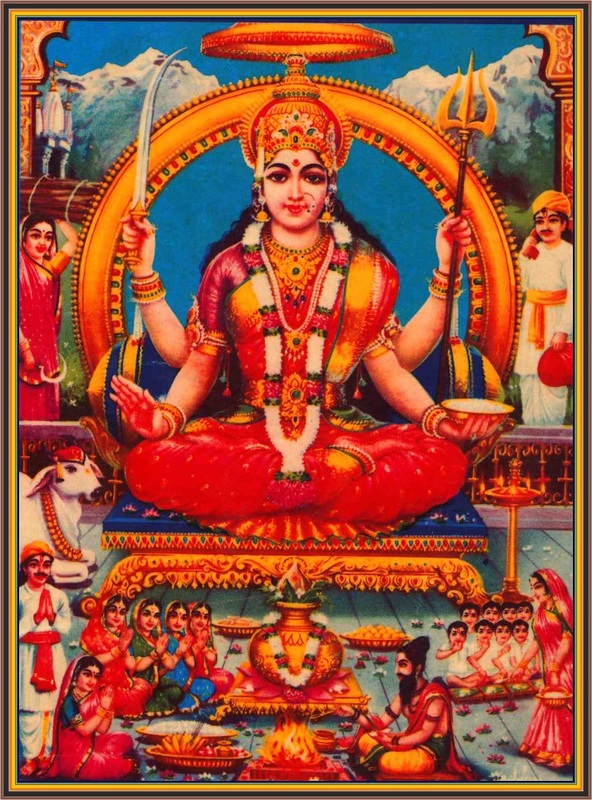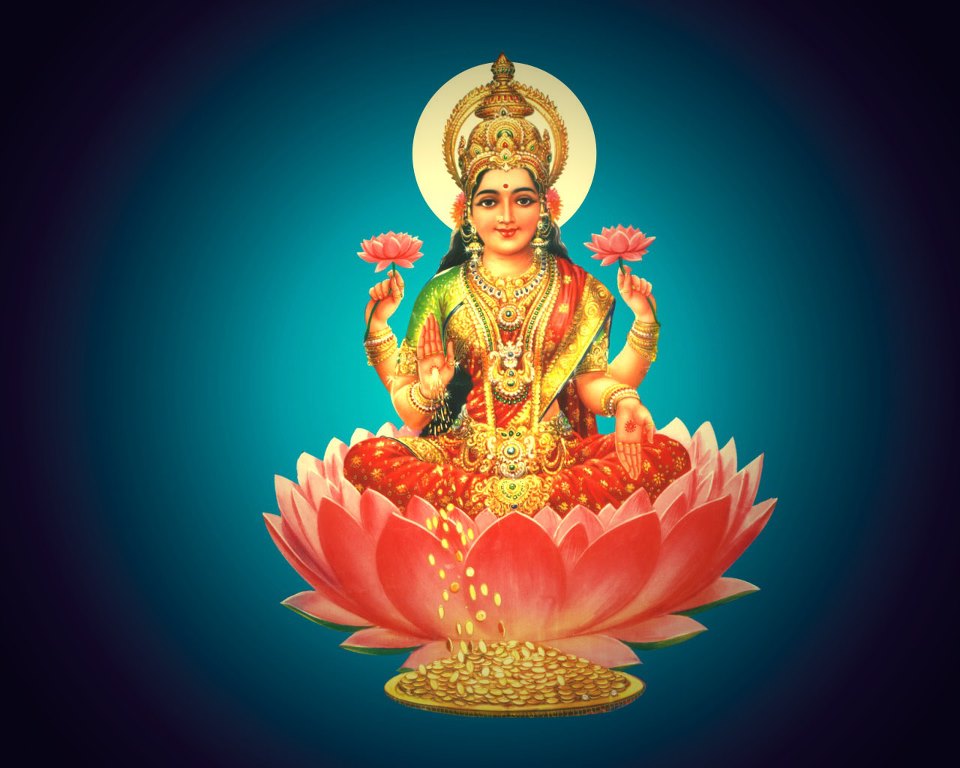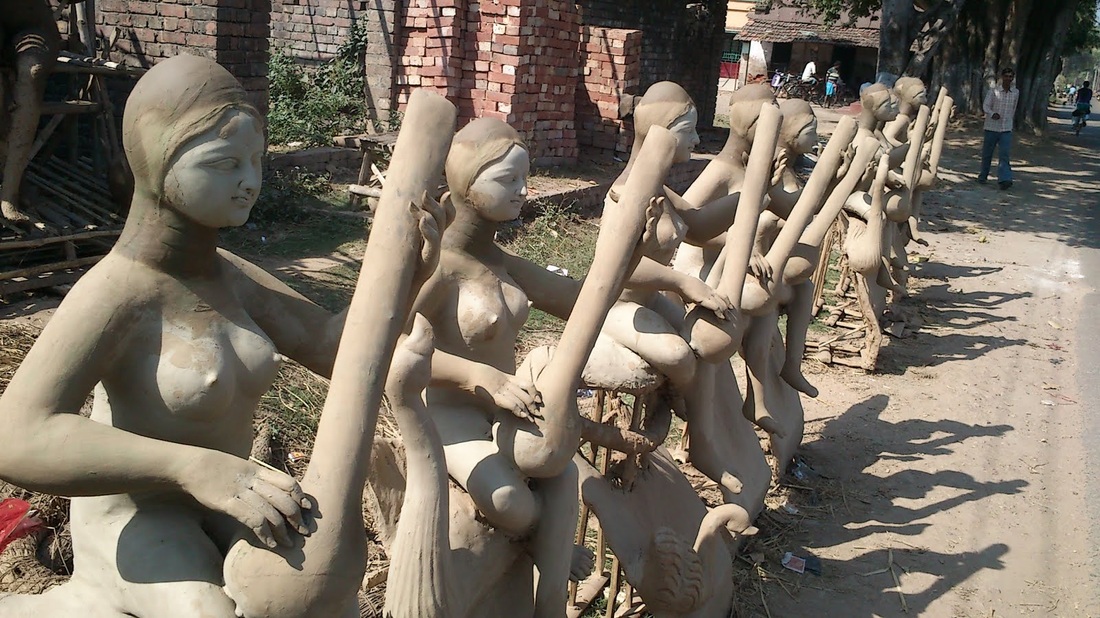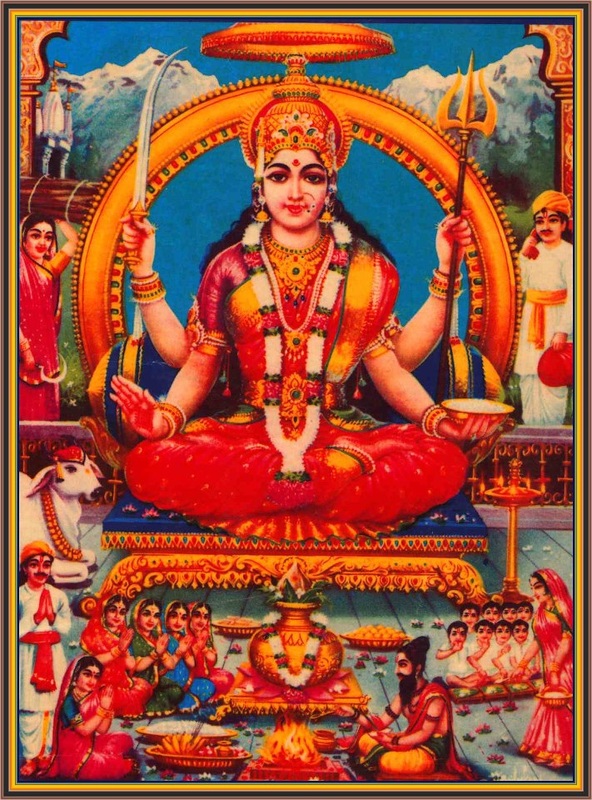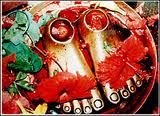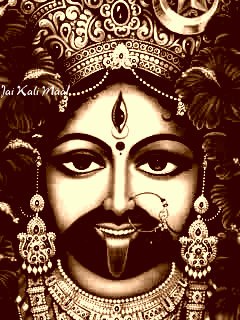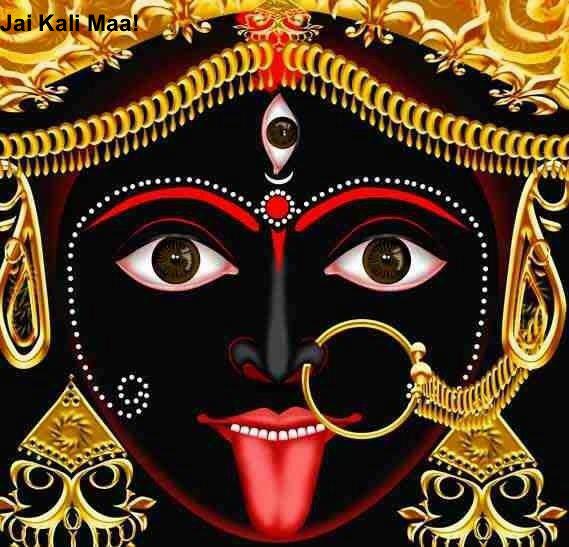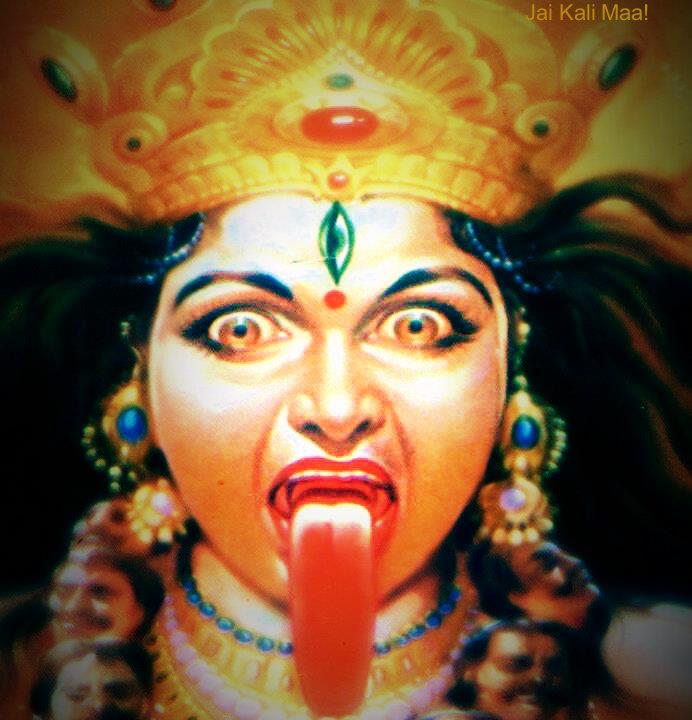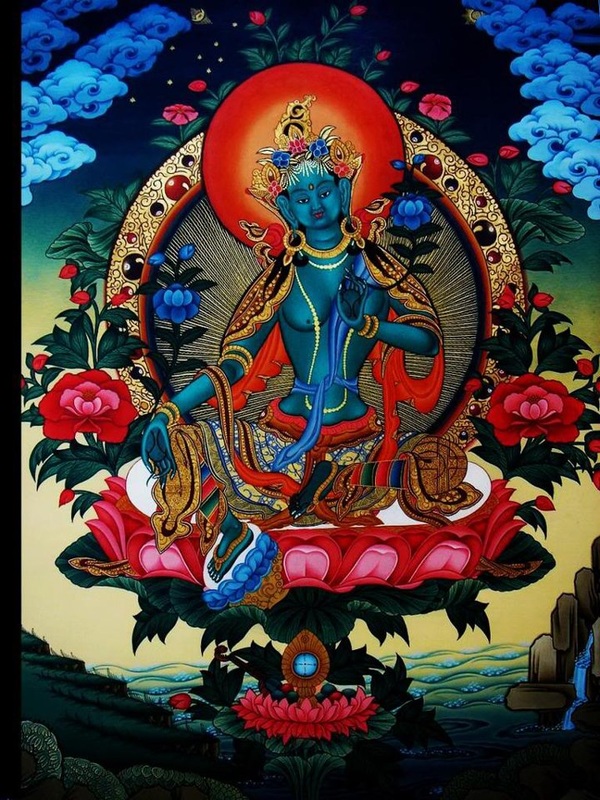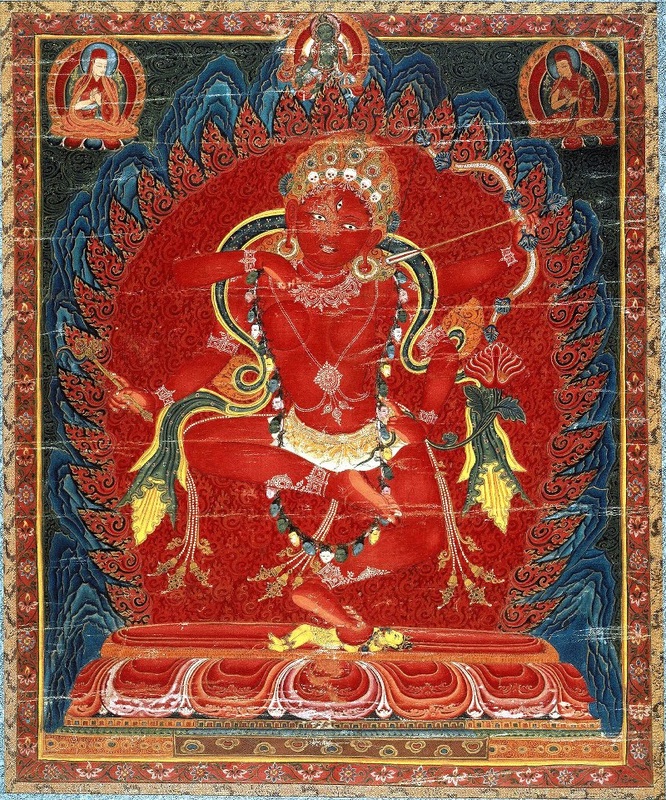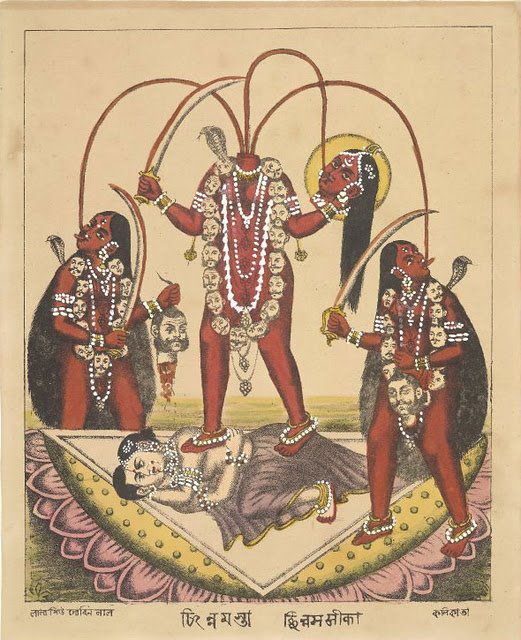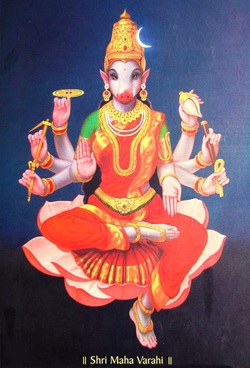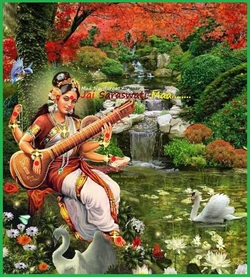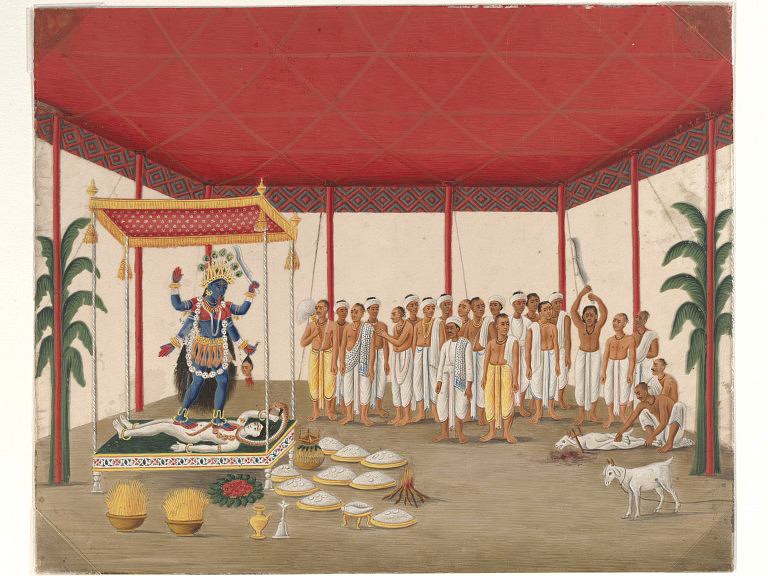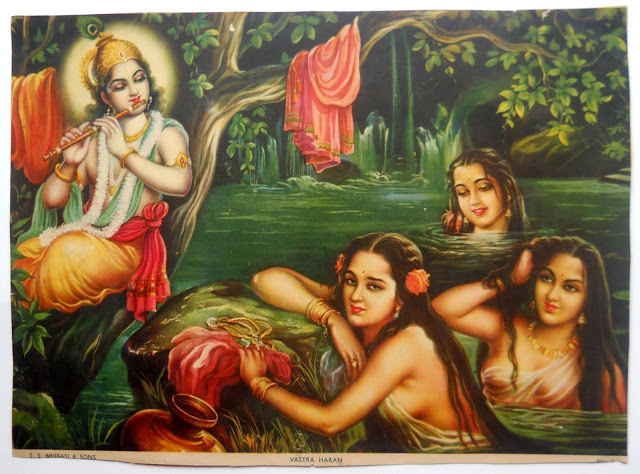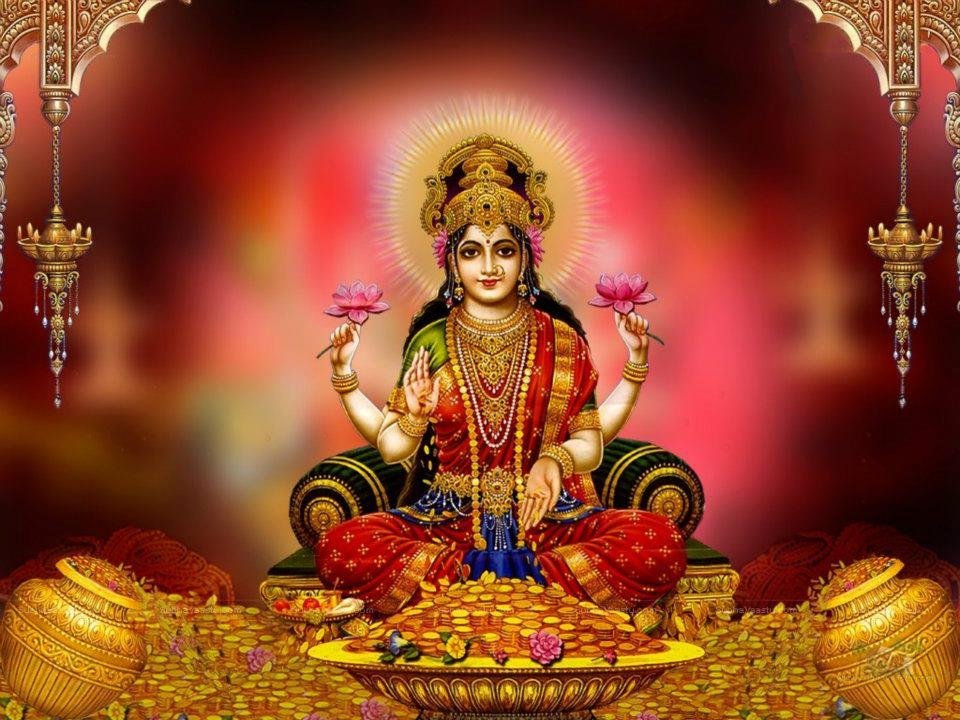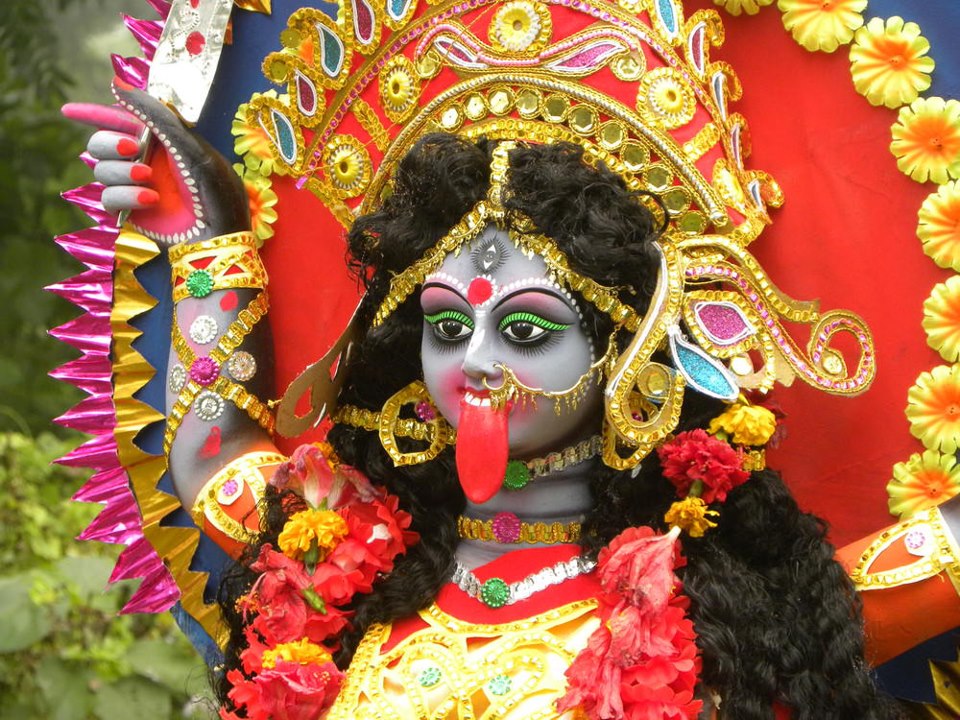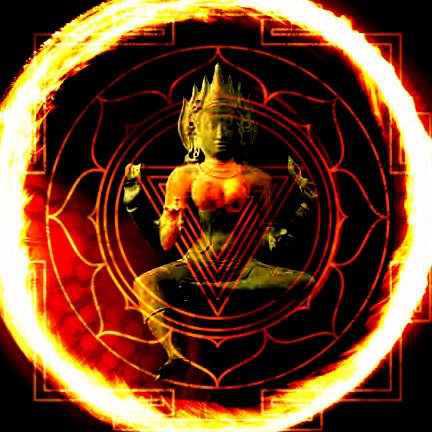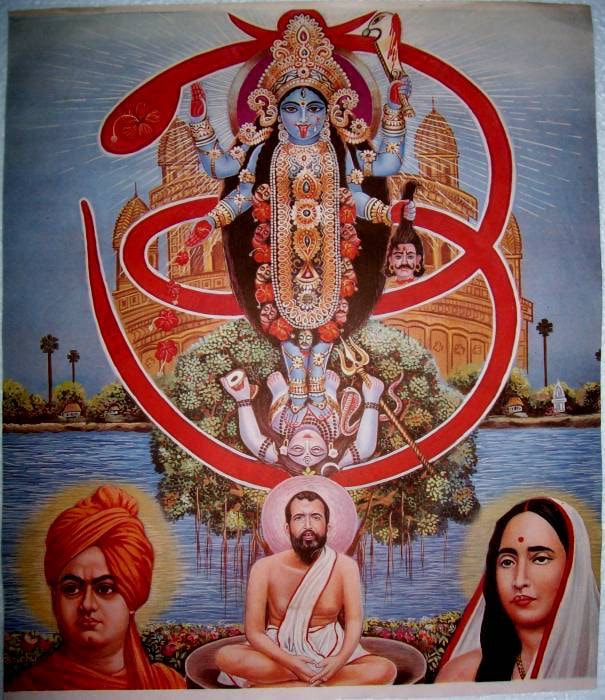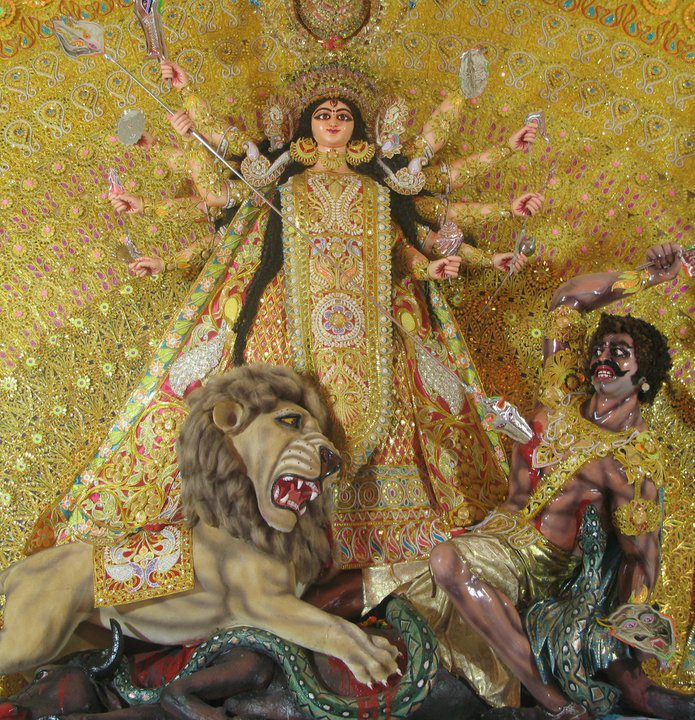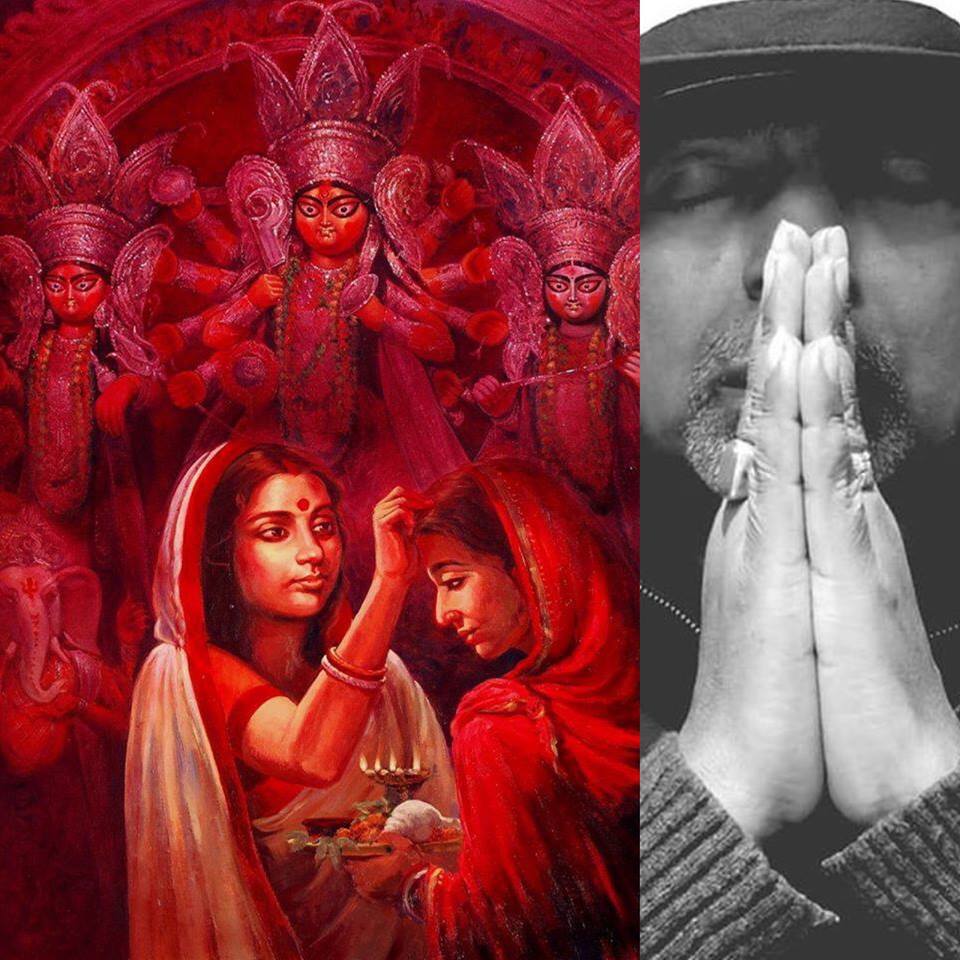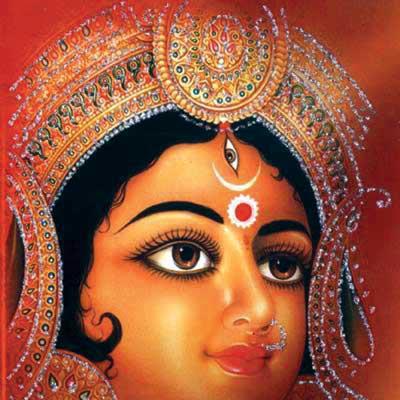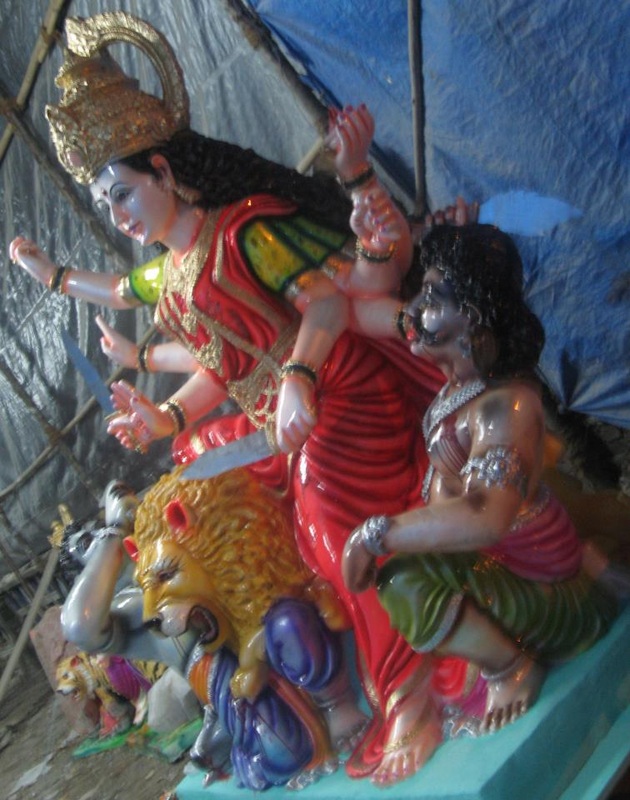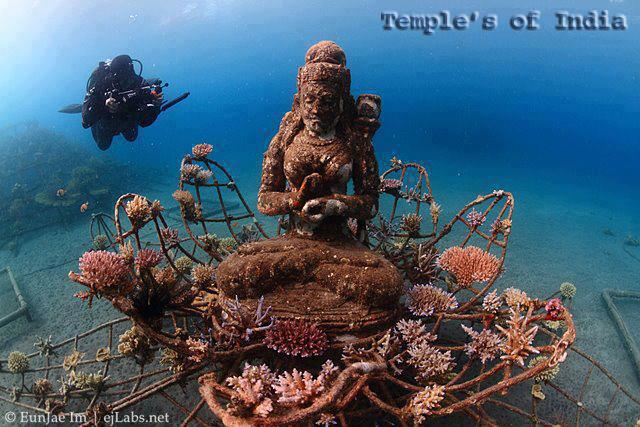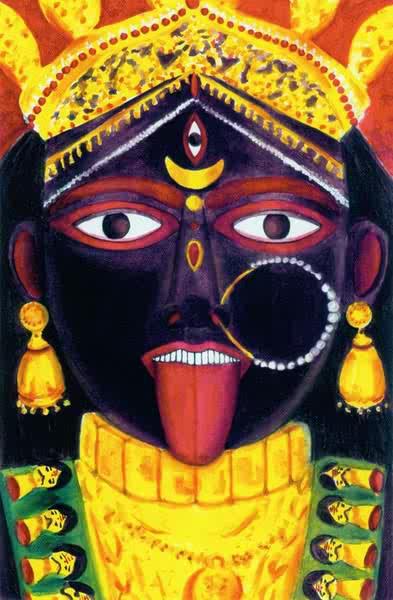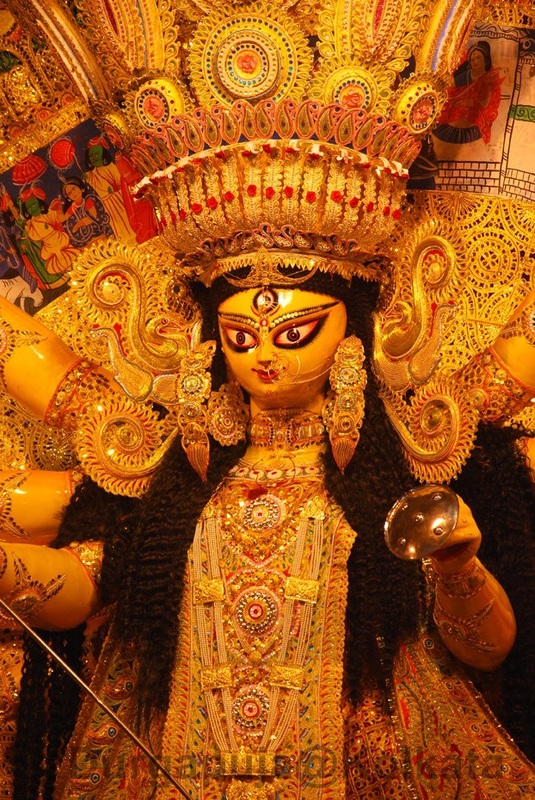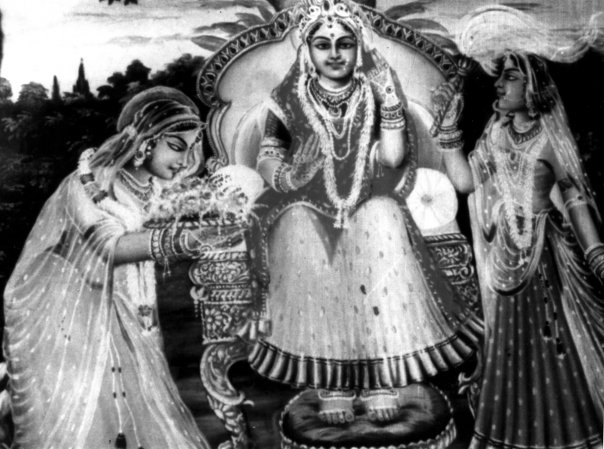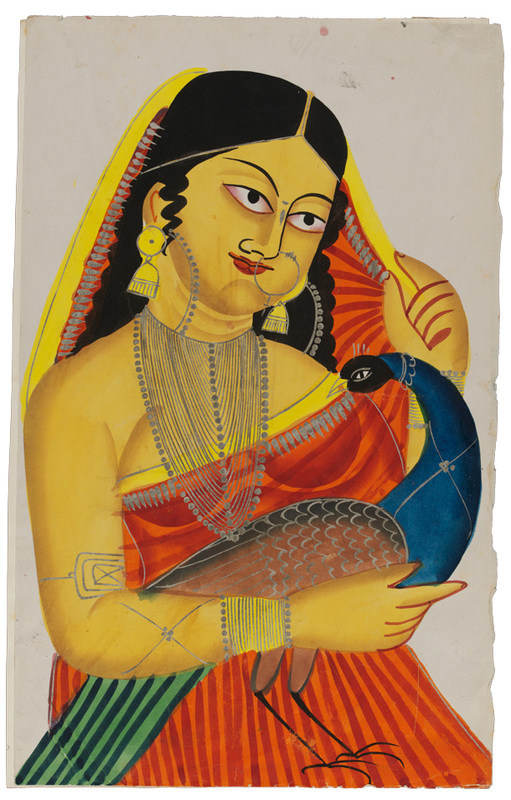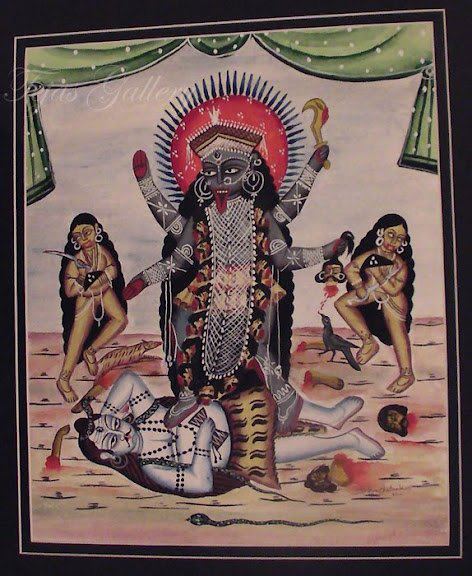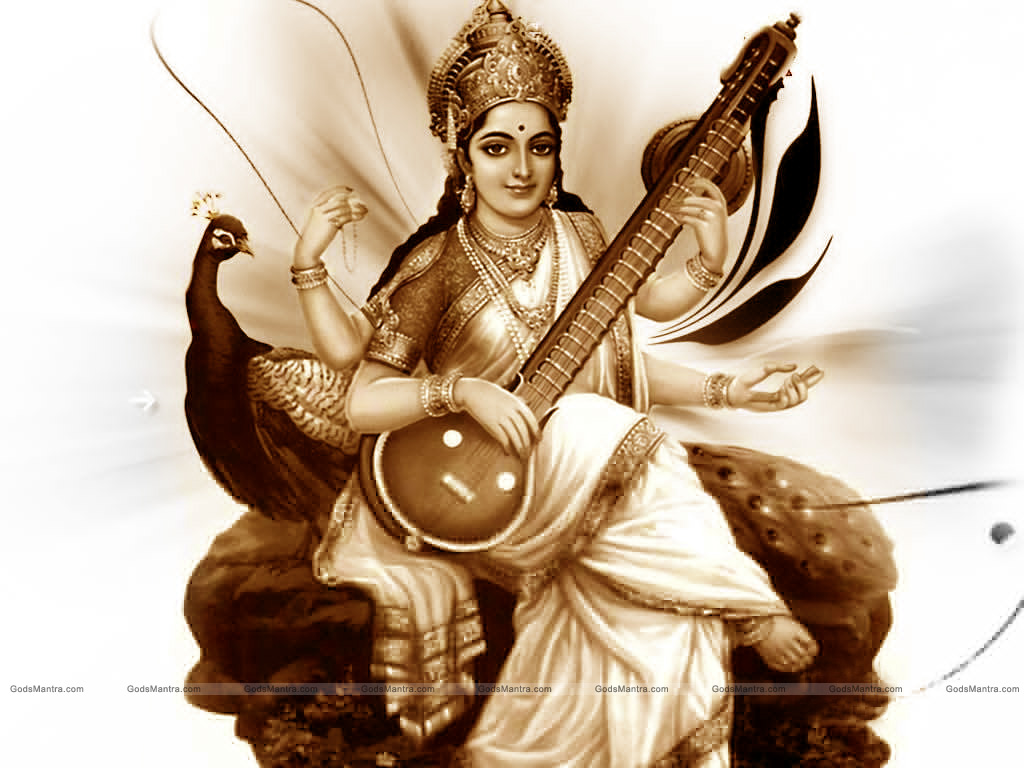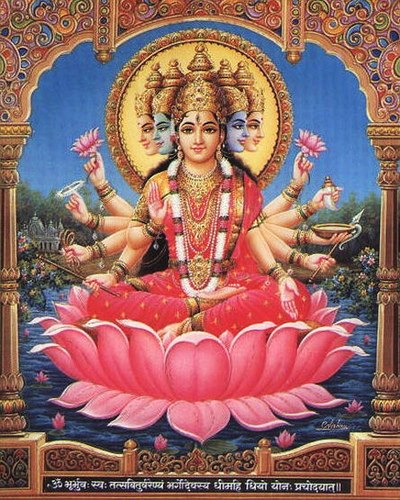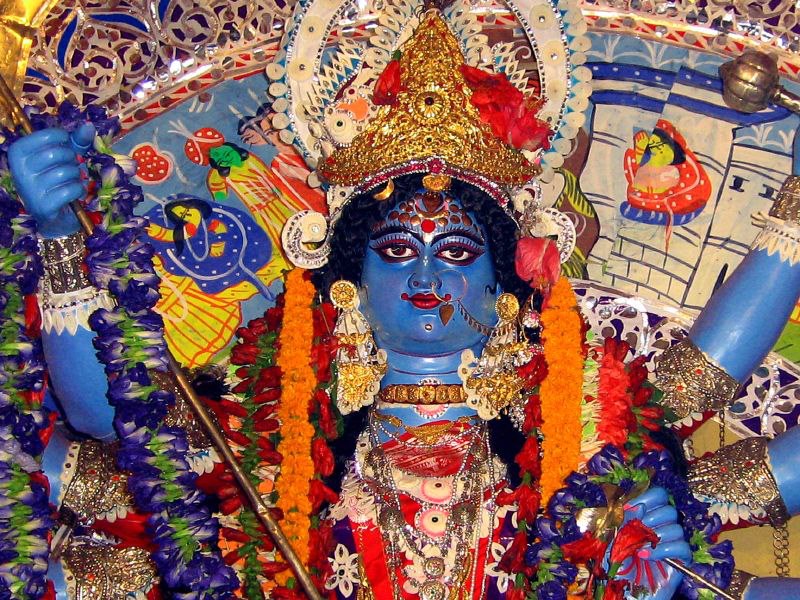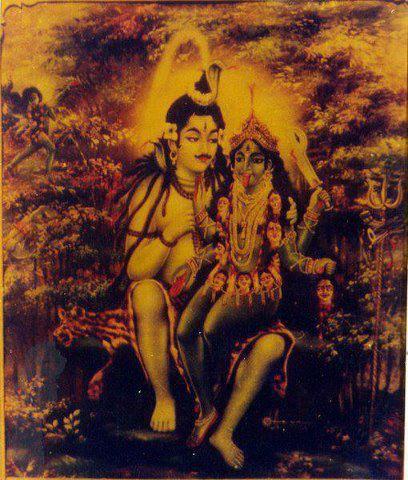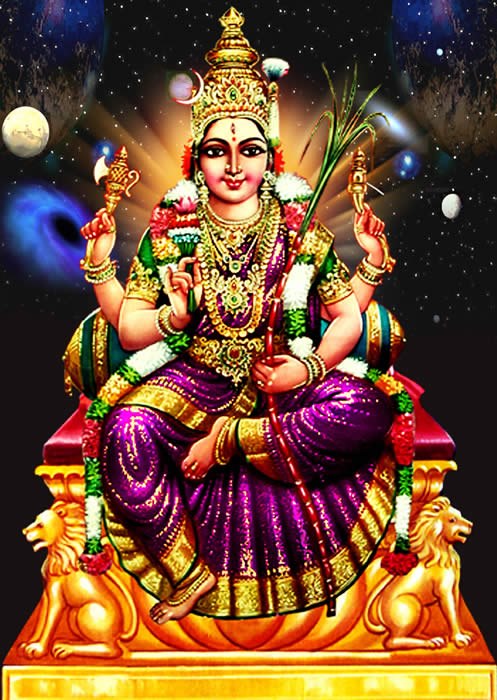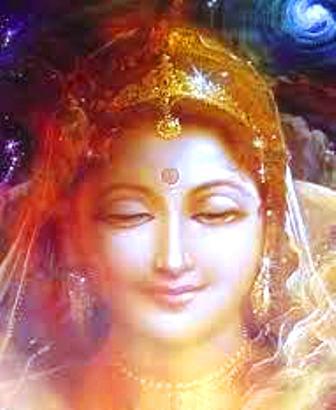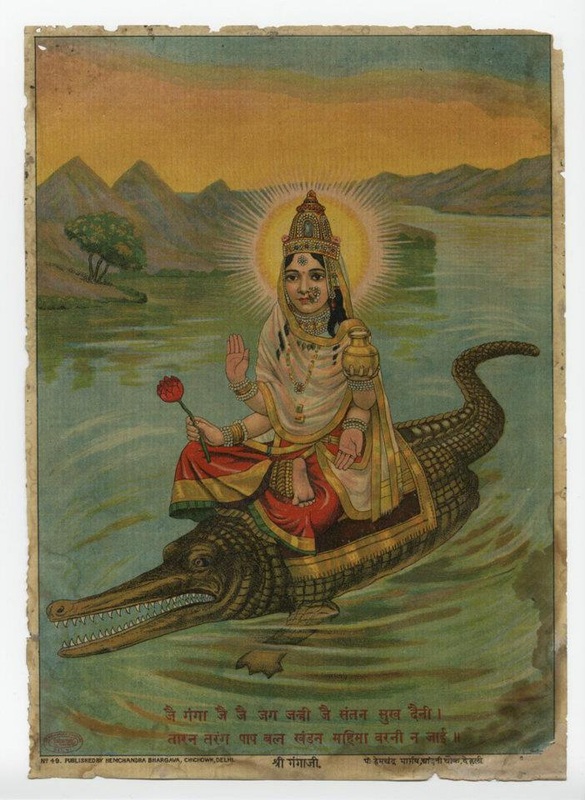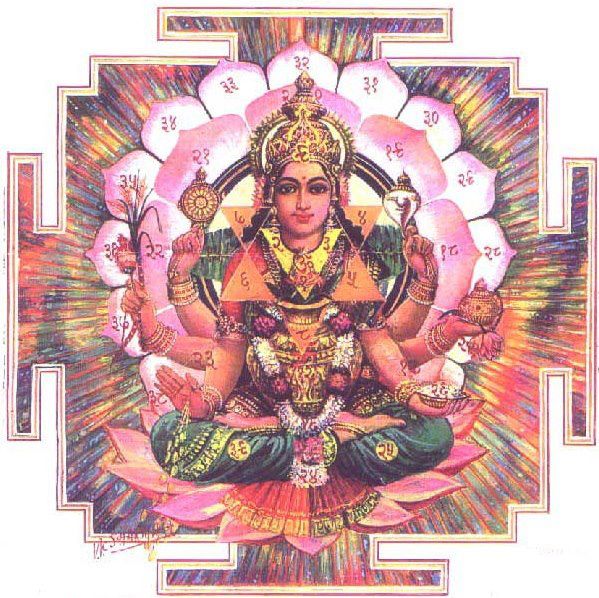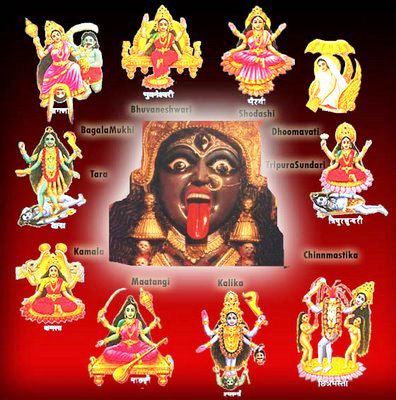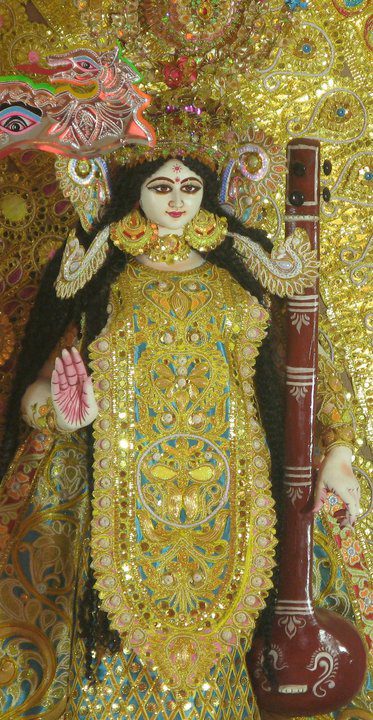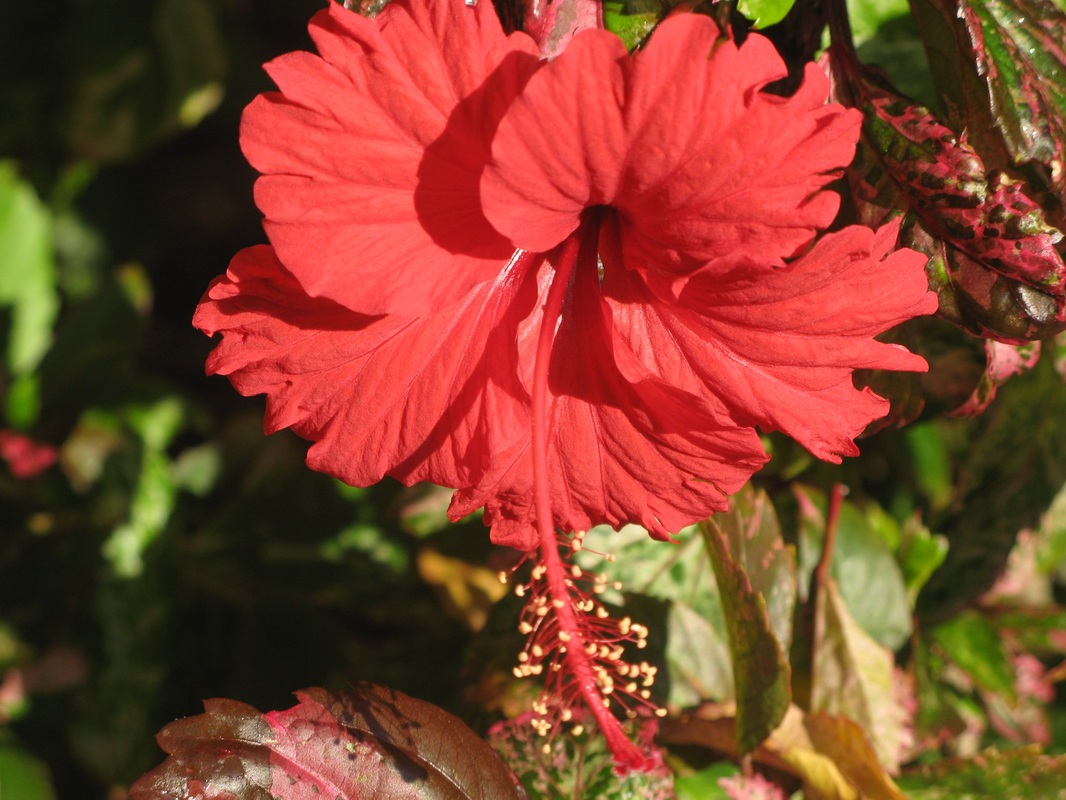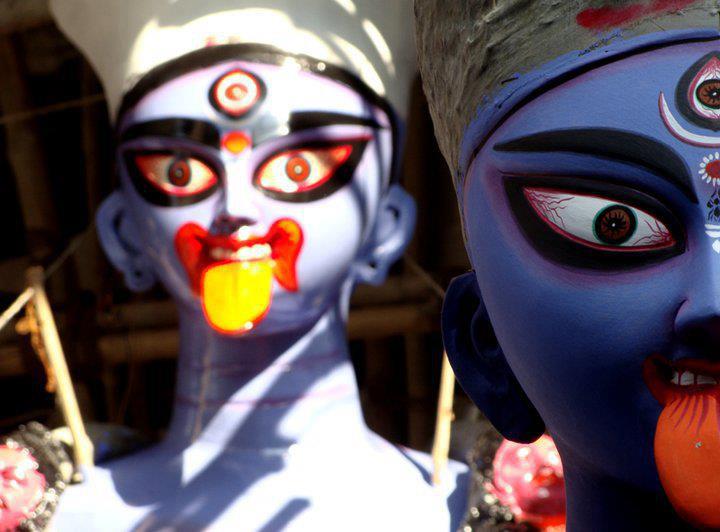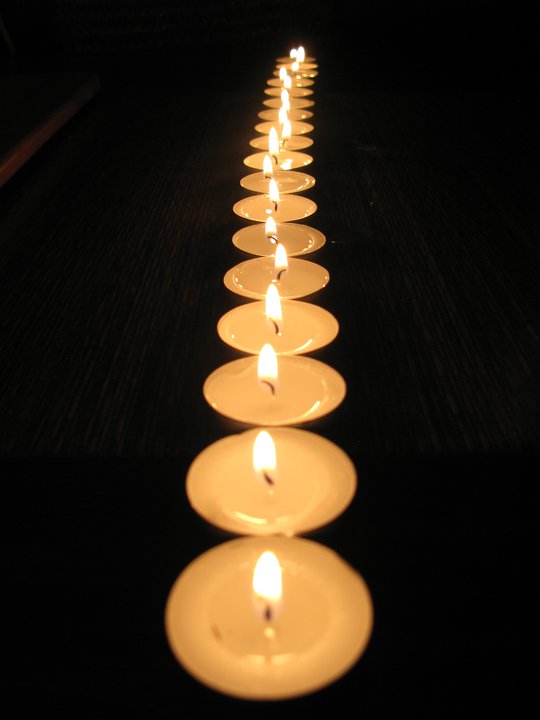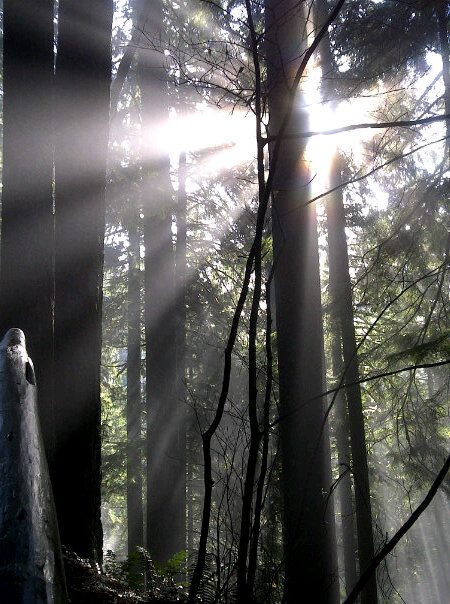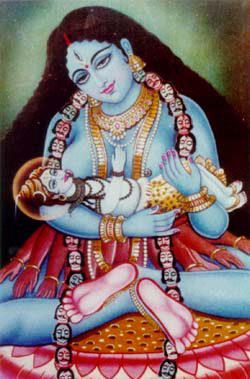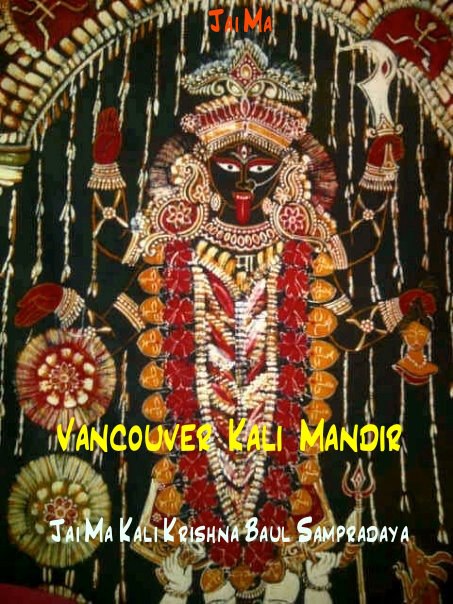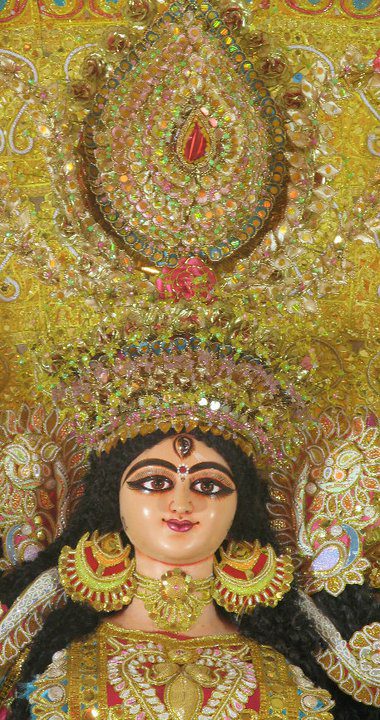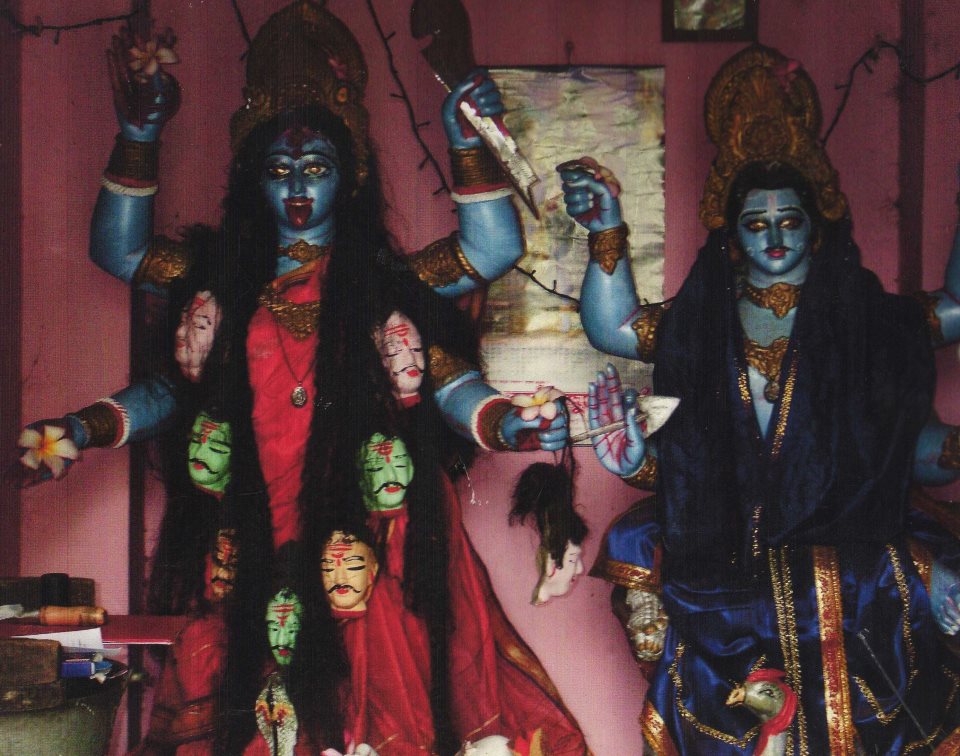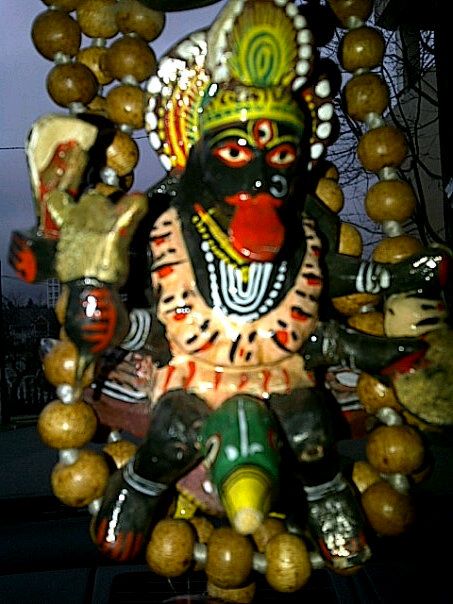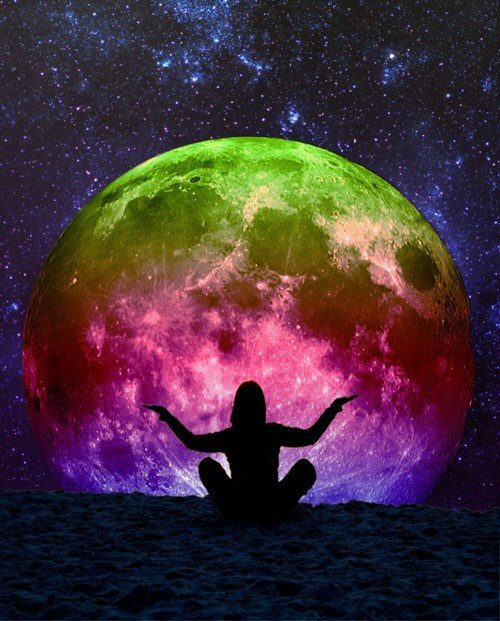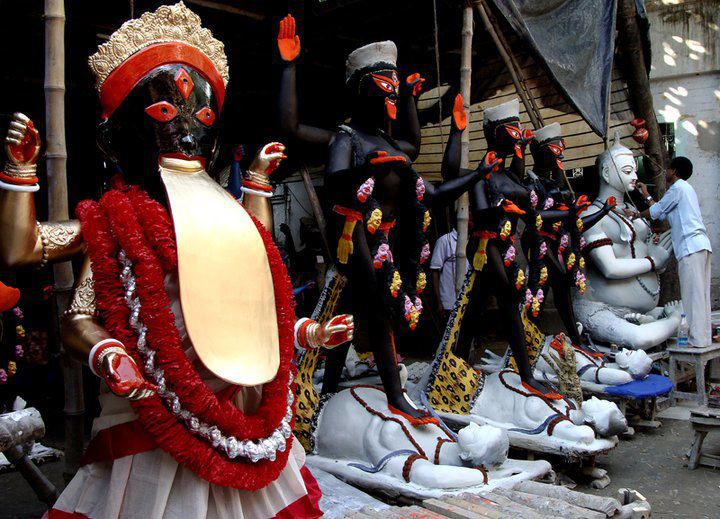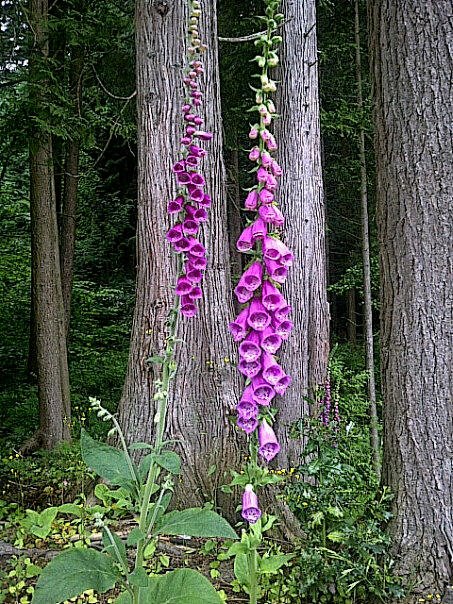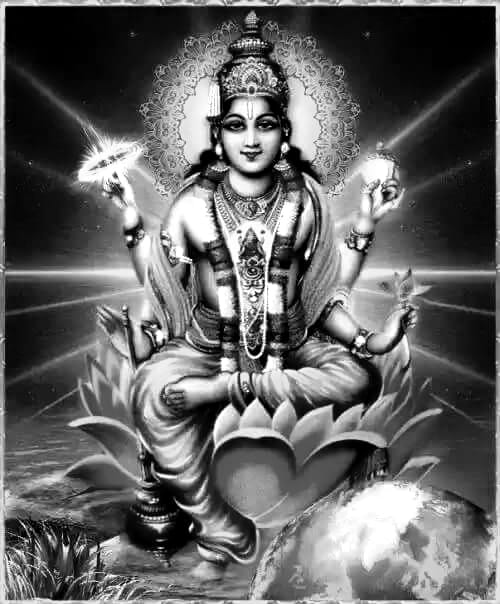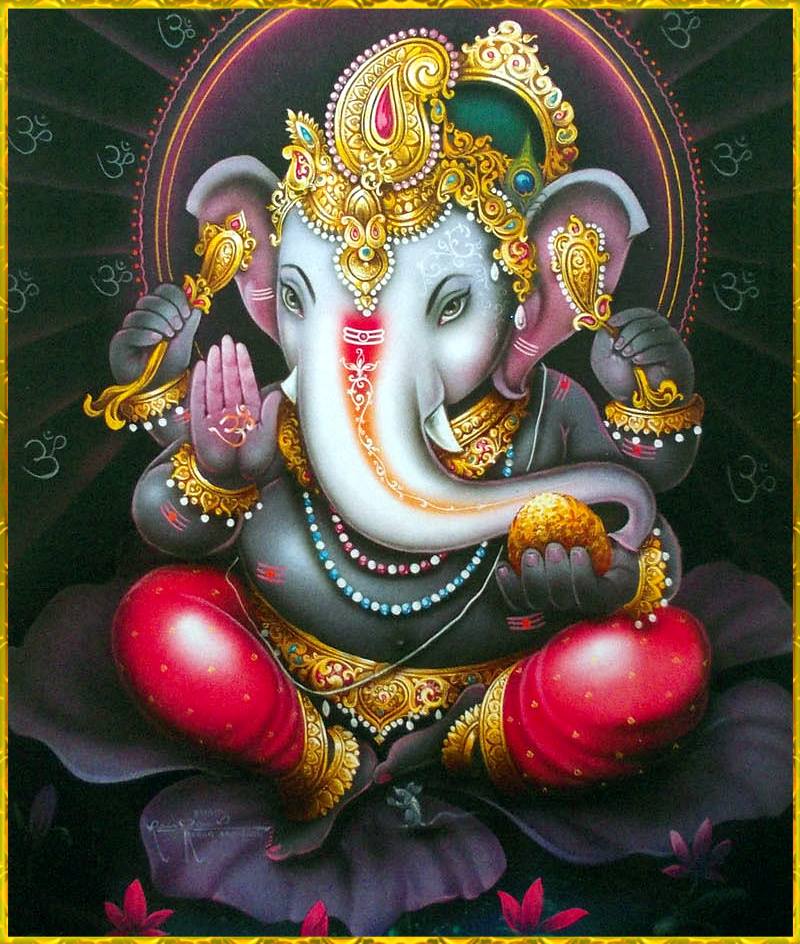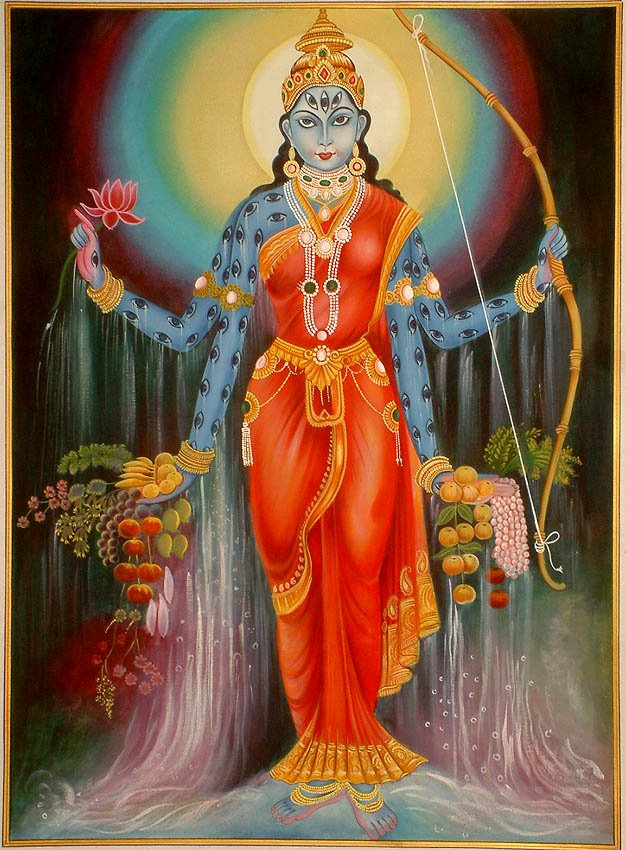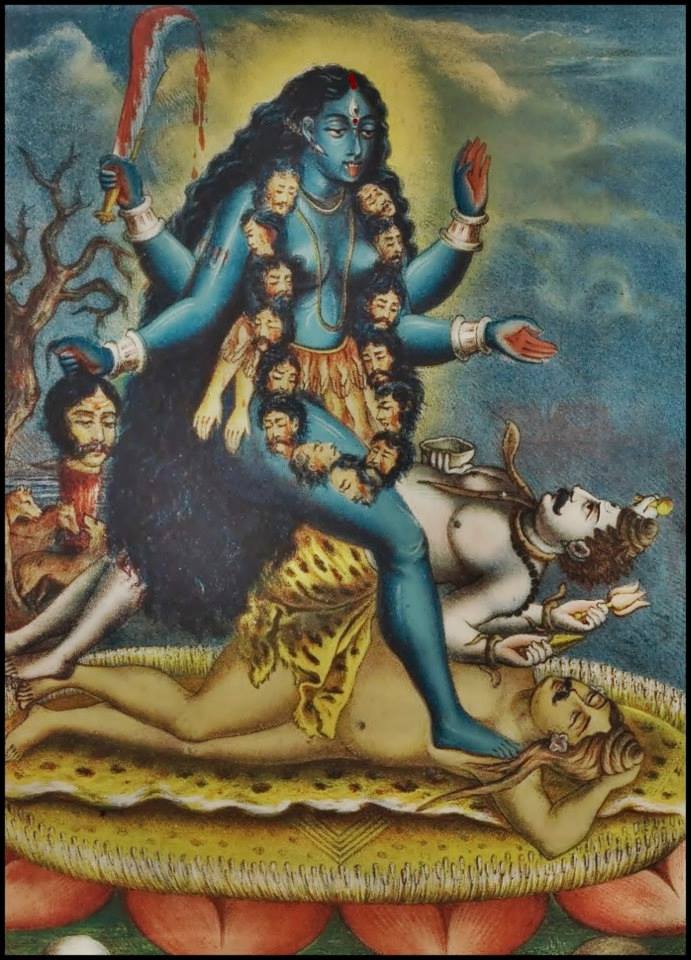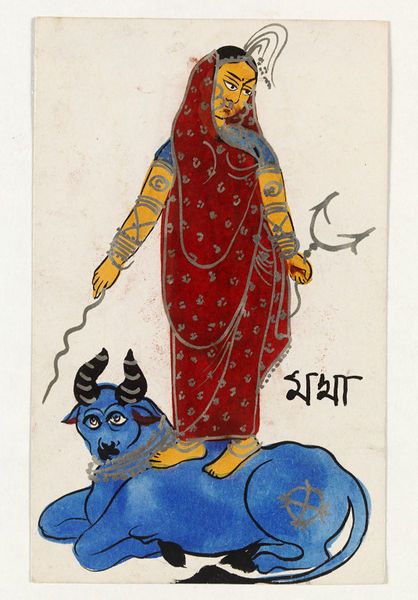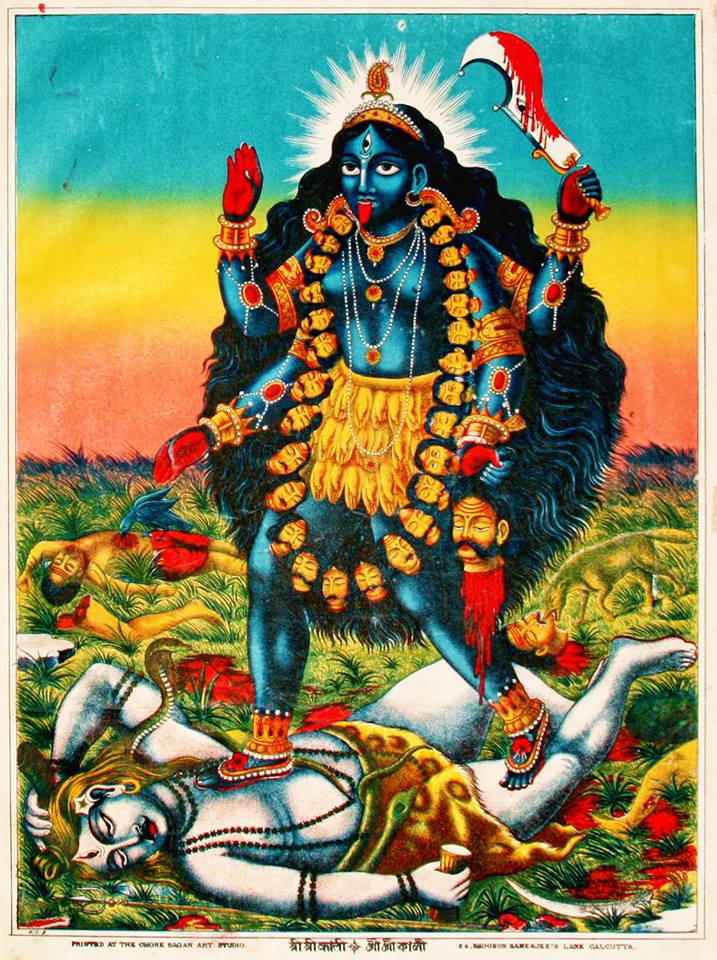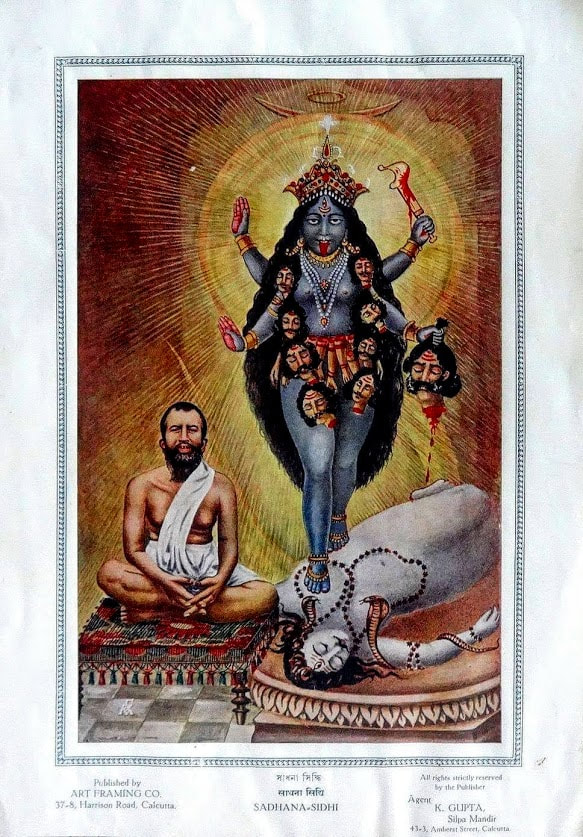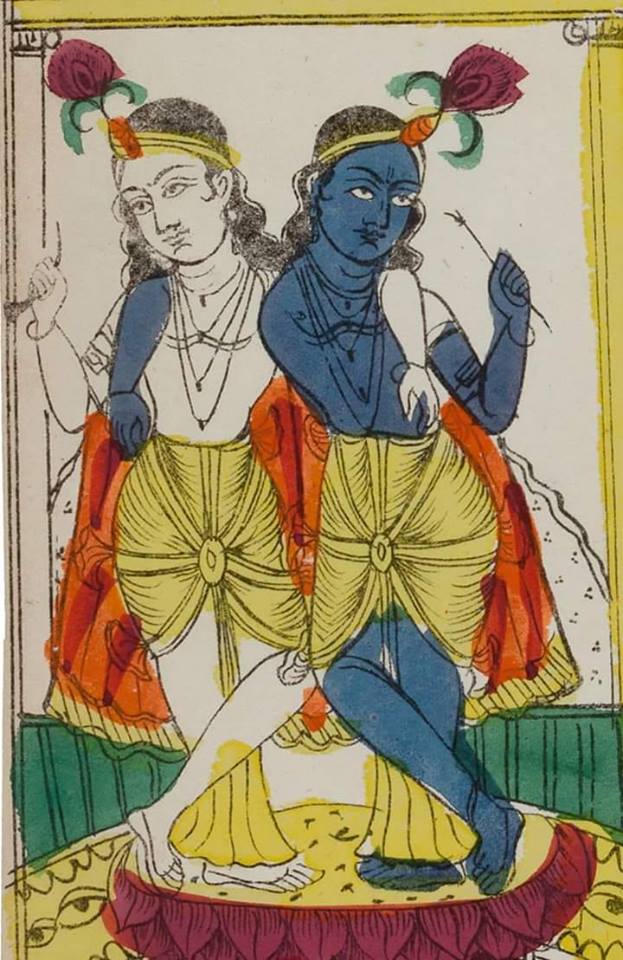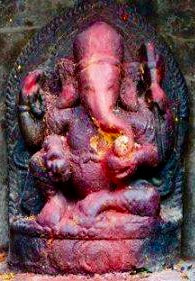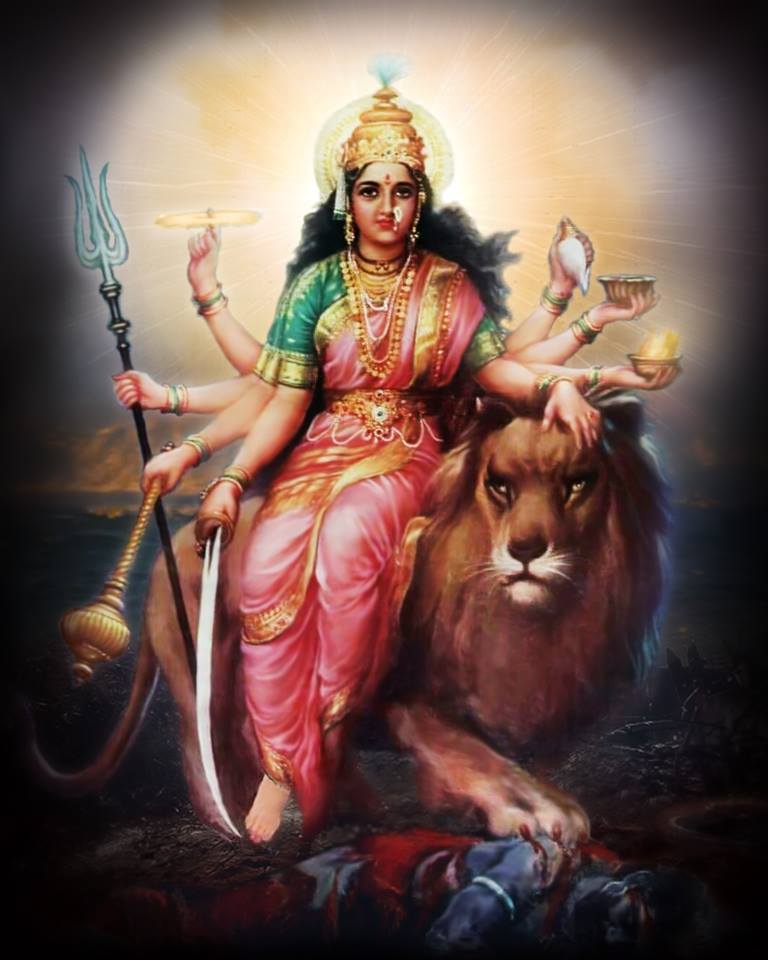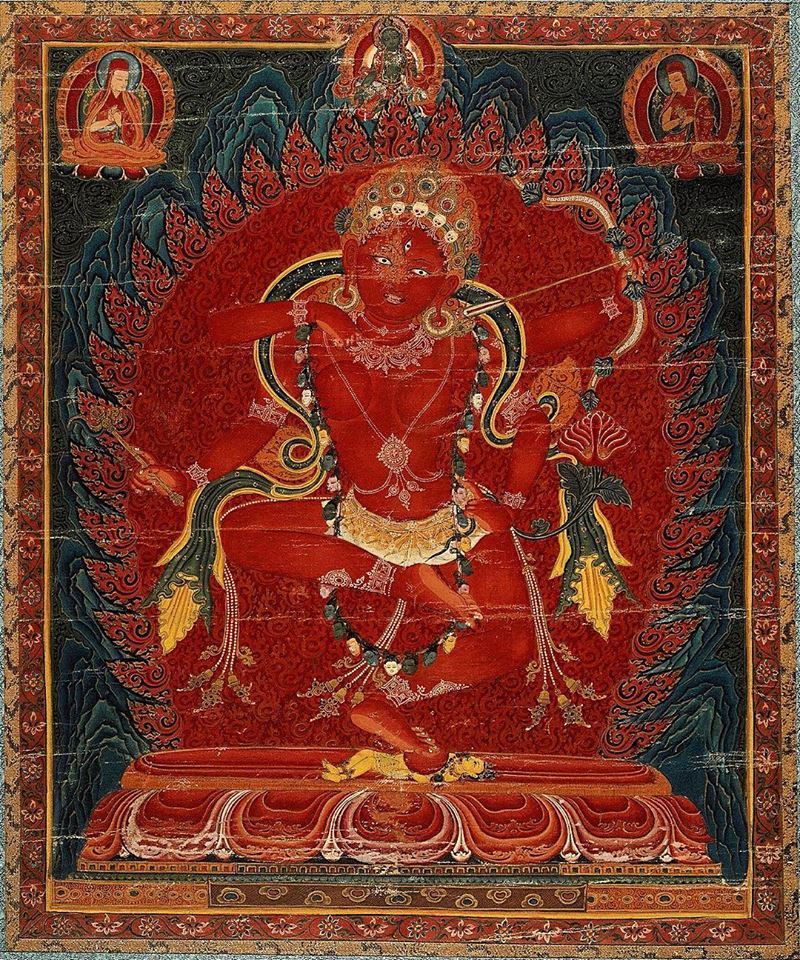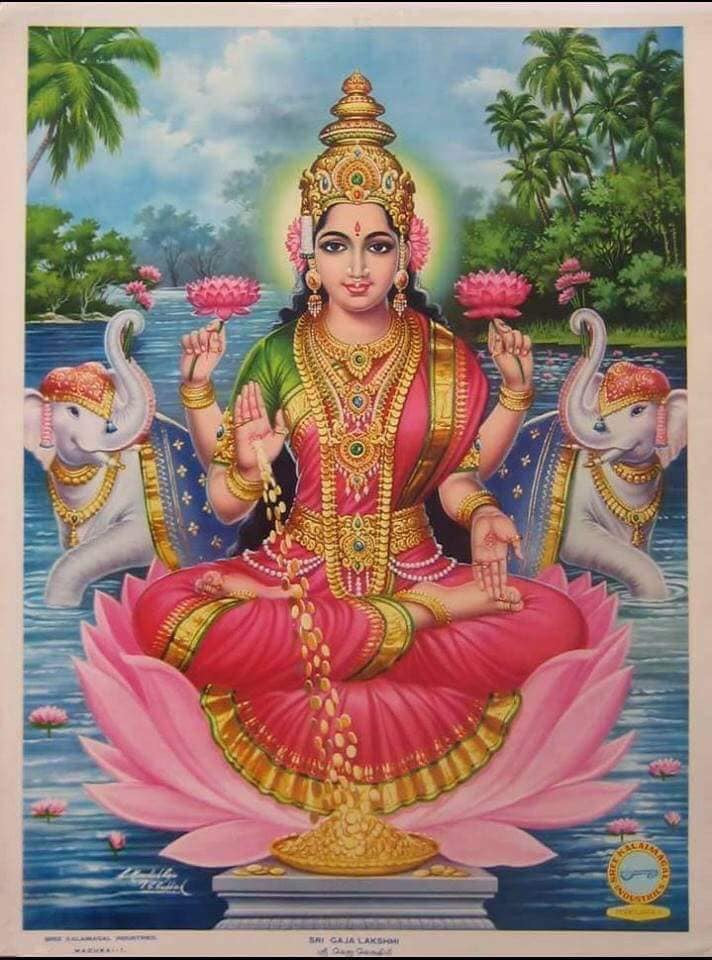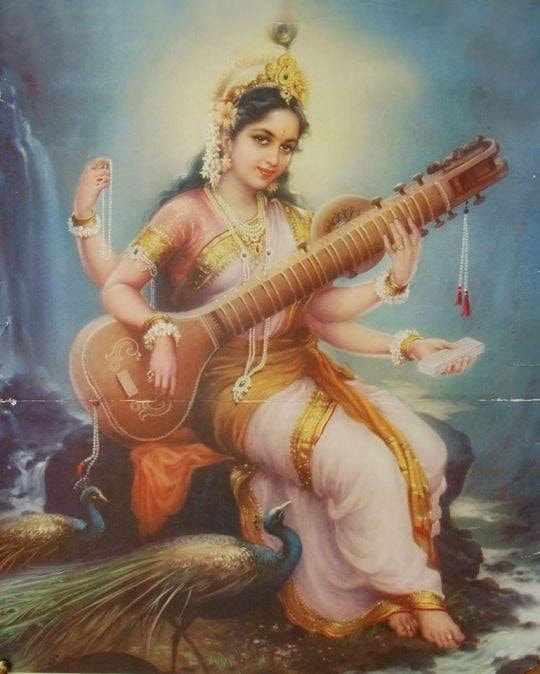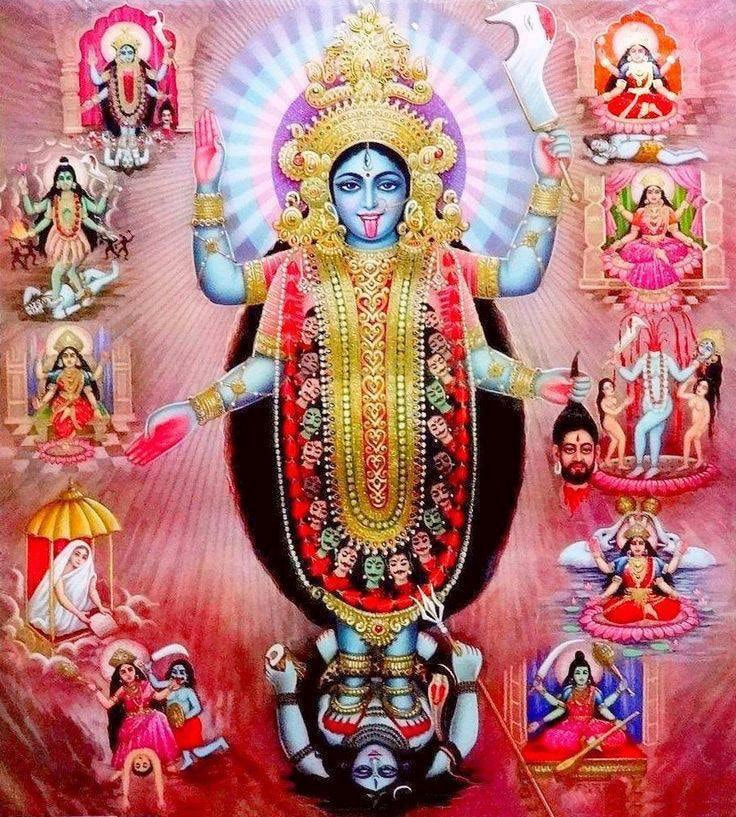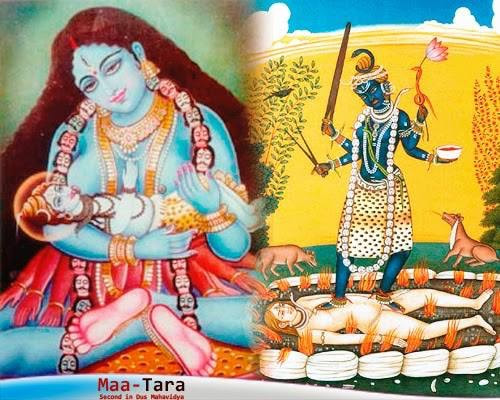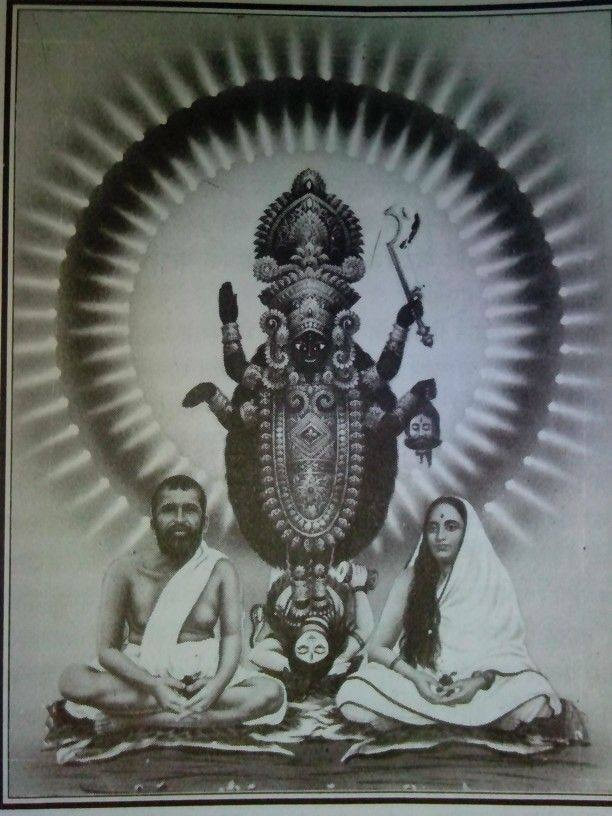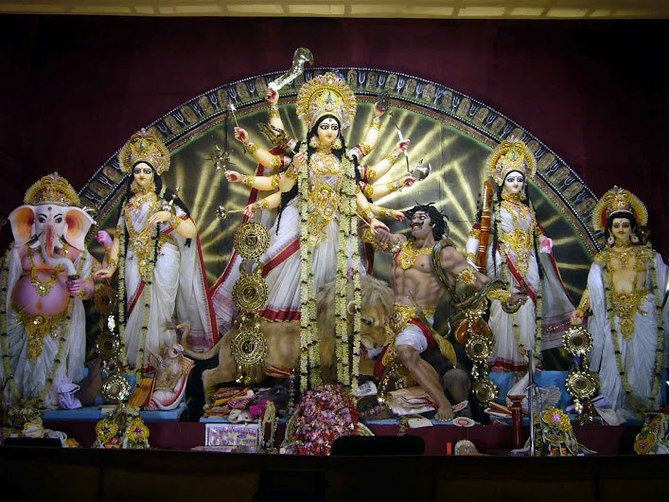
The nine forms of Durga are worshipped during the nine days of Navratri.
Sailaputri or Shailaputri Among the Nine Durgas, Maa Shailputri is considered to be the first manifestation of goddess Durga. She carries the trishul and the lotus in her hands. Her vehicle is the Bull, Nandi.
The narrative regarding her birth has been described in scriptures like Shivapurana and Devi Bagvaatam Maa.
Shailputri in her previous birth was born as a daughter to Daksha Prajapati. She was named ‘Sati’. She had been deeply devoted to Lord Shiva since her childhood. When she grew into a maiden, she propitiated Lord Shiva by her penance and devotion and desired to beget him as her consort. Lord Shiva bestowed the desired boon on her and accepted her as his consort.
Once her father Daksha Prajapati organized a great Yanja in which all the gods including Brahma, Vishnu, Indra and saints and sages were invited, but Lord Shiva was excluded. When Goddess Sati came to know of it, she could not tolerate the disgrace of Lord Shiva. So, she decided to pay a visit to her father. Getting angry Sati spoke to Lord Shiva, “O Dear Lord! My father Daksha Prajapati is performing a grand fire sacrifice. All the gods, saints, seers and sages have been invited to participate in this sacrifice, but he has disgraced you openly by not inviting you. I can never bear your insult. So, you kindly let me go to my father to speak out my mind to him.”
Seeing the infuriated Sati, Lord Shiva said to her, “O Goddess! It does not behoove you to lose your temper over such a trifle. Daksha Prajapati is the performer of this great sacrifice. It is his sweet will to invite or ignore any one. You must not poke your nose into his affairs. Such trivial steps may cause bitterness in your relations.”
Sati’s anger did not subside even after such a lecture given to her by Lord Shiva. Seeing her great obduracy, Lord Shiva ultimately granted her the permission to see her father.
When Goddess Sati reached the site of the Yajna, she heard everybody denouncing Lord Shiva. Even Daksha, her father, surrounded by his servants was busy with the condemnation of Lord Shiva. All her sisters were mocking at Sati. Such a hostile situation fanned the fire of her fury even more. She failed to endure such a horrible disgrace of her Lord and consigned herself to the sacrificial flames. When Lord Shiva heard of Sati’s self-immolation, he sent his attendants to destroy the sacrifice.
Sati in her next birth was born as a daughter to Himalaya, the Lord of Mountains. She was named Parvati or Hemvati. Since she was born as a daughter to the mountain-king Himalaya, she is also known as Shailputri. She propitiated Lord Shiva by her severe penance and begot him has her husband. Among the Nine Durgas, the importance and powers of Mother Shailputri are unlimited. On the first day of auspicious Navaraatri, she alone is adored and worshipped.
Mantras for Shailputri Devi
Om Devi Shailputryai Namah (108 recitation of this mantra)
Vande Vanchhit Laabhaay, Chandrardhkritshekharaam | Vrisharudham Shooldharaam Shailputriim Yashaswinim ||
I worship Goddess Shailputri to fulfill my wishes, who is adorned with crescent moon on her head, rides on a bull, carrying a trishul and is illustrious.
Brahmacharini In this form Durga is two-armed, clad in white and carries a rudraksha mala and sacred Kamandalu. She is in a highly pious and peaceful form or is in meditation. This form of Durga is related to the severe penance undertaken by Sati and Parvati in their respective births to attain Lord Shiva as husband. Some of the most important Vratas observed in different parts of India by women is based on the strict austerities followed by Brahmacharini. She is also known as Tapasyacharini and is worshipped on the second day of Navrathri.
The narrative regarding her birth has been described as follows:
Having immolated herself in the sacrificial fire, Sati was born of Maina as a daughter to the Mountain-King Himalaya. Keeping in view her auspicious traits, she was given the name of ‘Parvati’. When she had grown up into a beautiful maiden, the celestial sage Narada while roaming about happened to reach the court of king Himalaya. Sage
Narada was warmly welcomed by the Lord of mountains. Thereafter Himalaya and Maina prayed to Sage Narada to predict the future of Parvati by reading her palms. Sage Narada agreed to their request. Seeing Goddess Parvati, Sage Narada stood up and bowed to her with great reverence. The mountain-king Himalaya and queen Maina were amazed at such an unusual behavior of Sage Narada.
They were curious to know the cause of this unique behavior. Thereupon he spoke with a smile, “O Lord of Mountains! This daughter of yours in her previous birth was Sati, the daughter of Daksha and the consort of Lord Shiva. She sacrificed her body in the fire of the Yanja as Daksha hurled disgrace on Lord Shiva. Now she is born again as your daughter Parvati. That is why I bowed to her. By virtue of her merits, she shall again beget Lord Shiva as her husband.”
Having listened to the prediction of Sage Narada, Goddess Parvati inquired of him how to beget Lord Shiva as her consort. Thereupon Sage Narada advised her to perform an austere penance.
Acting upon the advice of Sage Narada, Goddess Parvati renounced all the pleasures of the palace and started performing penance to beget Lord Shiva as her husband. She spent the first thousand years of her penance by living on fruit and roots. Thereafter she lived on leaves for another three thousand years of her penance. Then she lived on water and then air alone braving heat and cold, rain and storms and all kinds of sufferings.
Goddess Parvati meditated on Lord Shiva for thousands of years. The austere penance performed by her reduced her to a mere skeleton. A great hue and cry prevailed in the three worlds because of her severe penance. All the Gods including Indra and Saints and Sage were terrified by her penance. They approached Brahma in a body and prayed to him to bestow the desired boon on Parvati.
At last Brahma, appeared before Parvati and said to her, “O Goddess! All the Gods bow to you in deep reverence. Such an austere penance can be performed only by you. Your cherished desire shall soon be fulfilled. You shall beget Lord Shiva as your consort. By virtue of this austere penance you shall be known as “Brahmchaarini” – a woman of celibacy. Thereafter Brahma restored her physical charm and grace.
Thus Goddess Parvati begot Lord Shiva as her husband by virtue of her penance. She earned the reputation of being a Brahmchaarini.
The worship of Maa Brahmchaarini is conducive to penance, renunciation, virtue and nobility. Her devotees are endowed with peace and prosperity.
Mantras for Devi Brahmacharini
Om Devi Brahmcharinyai Namah (108 recitation of this mantra)
Dadhaanaa Kar Padaabhyaamakshmala Kamandalu | Devi Prasidati Mayi Brahmcharinyanuttamaa.
Which means, O Goddess Brahmcharini, who holds rosary and Kamandalu in her hands, please on me.
A devotee who is eager to know God, who want knowledge, he should worship Devi Brahmcharini on the second day of Navratri.
Chandraghanta or Chandra-khanda In this form Durga is 10-armed and rides a tiger. This is a terrible aspect and is roaring in anger. This form of Durga is completely different from earlier forms and shows when provoked she can be the terrible or malevolent. Chandraghanta is worshipped on the third day of Navarathri.
Her forehead is bedecked with the crescent moon resembling the shape of a ghantaa. That is why she is called Maa ‘Chandraghantaa’ by devotees.
By her grace all the sins, distresses, physical sufferings, mental tribulations and ghostly hurdles of the devotees are eradicated. Riding on the lion the Mother inspires her devotees with fearlessness. She is the very embodiment of serenity. The devotees who adore and worship her with their deeds, minds and speech develop an aura of divine splendor. Their persons emit out invisible power-waves which exercise
a great impact on those who come in contact with them. They easily achieve success in every walk of life. Maa Chandraghantaa is ever ready to destroy the wicked, but to her devotees she is ever visible as the kind and compassionate Mother showering peace and prosperity.
The complexion possessed by Maa Chandraghantaa is golden. She possesses ten arms which wield weapons and missiles like the sword, the bow, the mace, the arrows and the like. During the battle between the gods and the demons, the horrible sound produced by her ghantaa had sent thousands of wicked demons to the abode of the Death-god. She is ever in a warring posture which shows her eagerness to destroy the foes of her devotees so that her devotees may ever live in peace and prosperity. Divine vision is acquired by her grace. If a devotee happens to enjoy divine fragrance and hears diverse sounds, he is said to be blessed by the Mother.
Maa Chandraghantaa should be adores and worshipped with great purity in mind and heart observing all the rites properly. Having acquired her grace, we get rid of all worldly turmoil and enjoy Supreme bliss. Devotees should always have her gentle form in their minds while meditating on her.
Mantras for Chandraghanta Devi
Om Devi Chandraghantayayi Namah (108 recitation of this mantra)
Pindaj Pravaarudh chandkopastrkairyuta | Prasadam Tanute Madhyam Chandraghanteti vishrutaa ||
Which means, O Goddess Chandraghanta, who rides on Tiger, angry on enemies, holds many weapons in 10 hands, be propitious to me. Devotees, who have many enemies and obstacles in their life, should worship Devi Chandraghanta on third day of Navratri. Goddess Chandraghanta then destroy all obstacles and fears of devotee and destroy enemies and demons.
Kushmanda The fourth manifestation of Goddess Durga. She is adored and worshipped on the fourth day of the Navaraatri. She dwells in the abode of the Sun God. That is why her hue and spendour is as brilliant as the sun itself. It is her spendour that pervades every plant and creature of this universe. All the ten quarters are illuminated by her divine refulgence.
The name Kushmanda is made of three other words that are “Ku + Ushma + Amnda= Kushmanda”. Here “Ku” is “Little”, “Ushma” is “Warmth or Energy” and “Anda” is “Egg” , meaning the one who create the universe as “Little Cosmic Egg” with the energy of Her divine smile, is called “Kushmanda”.
When this universe was non-existent and darkness prevailed everywhere, it was Maa Kushmaandaa who produced the Cosmic Egg with her mere smile. So Maa Kushmanda is also known as the creator the whole universe. Maa Kushmanda is also named as “Adi Shakti”. She is the only one who has the power and strength to live in the core of Suryaloka. Her body shines like the glowing Sun. All directions get light from Her Divine smile including the Sun God itself. Maa Kushmanda also known as “Ashtabhuja” as she is often depicted as having eight arms. In her seven hands she holds Kamandalu, Bow, Arrow, Lotus, a Jar of Nectar, Discus, and Mace. In her eighth hand she holds a mala capable of giving eight Siddhis and nine Niddhis. She rides a lion who represents “Dharma”. On worshiping Her, ailments and sorrows are eliminated and life span, name, strength and health improved.
Mother Kushmaandaa is the bestower of all pleasures. Her adoration and worship delivers a person from all kinds of ailments and leads him on to the path of prosperity and pleasures. So, a devotee should adore and worship her with a purified mind and intellect.
Mantra for Kushmaandaa Devi
Om Devi Kushmandayayi Namah (108 recitation of this mantra)
Suraasampoornam Kalasham Rudhiraaplutamev Cha | Dahdana Hastpadmaabhyaam Kushmanda Shubhdaastu Me ||
Which means, Goddess Kushmanda who holds two pitchers full of Madira and Blood in her lotus hands, be propitious to me.
Goddess Kushmanda is Mother of Sun. She creates the entire universe and solar system. Devotees must worship her in order to get success in her creation. Devotees, who has malefic Sun in their birth chart should worship Kushmanda Devi.
Skanda Mata In this form Durga is four-armed and rides on a lion. She carries a lotus, a kamandalu and a bell. Her one hand is in blessing posture.
Skandamaataa is the fifth manifestion of Goddess Durga. She is worshipped on the fifth day of the Navaraatri. Her son Karttikeya is also called Skanda. So, she is called Skandamaataa or the Mother of Skanda.
Lord Skanda can be seen in her lap. She possesses four arms out of which two hold the lotus flowers. One of her hands is always in the boon-conferring gesture and with the other she holds her son Skanda in her lap. Her complexion is white and she is seated on the lotus. So, she is also called the Goddess with a lotus-seat. The Lion also is her vehicle.
Skandamaataa who possesses the brilliance of the sun fulfills all the desires of her devotees. He who is selflessly devoted to her, attains all the achievements and treasures of life. The worship of Skandamaataa purifies the heart of a devotee. While worshiping her, he devotee should have absolute control over his senses and mind. He should free himself from worldly bondage and worship her with a single-pointed devotion. Her worship is twice blessed. When the devotee worships her, Lord Skanda, her son in her lap, is automatically worshipped. Thus the devotee happens to enjoy the grace of Skandamaataa along with the grace of Lord Skanda.
If a devotee worships her devoid of selfishness, the Mother blesses them with power and prosperity. The devotees who worship Skandamaataa shine with divine splendor. Her worship is ultimately conducive to salvation.
Mantras for Skandamaataa Devi
Om Devi Skandmatayayi Namah (108 recitation of this mantra)
Sinhaasangataam Nityam Padmaanchit Kardwayaa | Shubhdaastu Sadaa Devi Skandmata Yashaswini ||
Which means, Skandmata, who rides on Lion with Kartikeya, holds lotus in her two hands and Varmudra in one hand, be propitious to me.
Skandmata take care of a devotee as her own child. Devotees must worship Skandamata specifically if they have many obstacles in life. Skandmata then take care of devotee as her own child and remove all his obstacles.
Katyayani In this form Durga is four-armed and she carries a sword, shield and lotus. One hand is depicted as giving blessing. She rides a lion.
Mother Kaatyaayani is worshipped as the sixth manifestation of Goddess Durga. She is adored on the sixth day of the Navaratri. The narrative regarding her birth has been as follows:
The world-renowned sage Kaatyaayana was born in the dynasty of sage Kaatya. He was an excellent devotee of Goddess Durga and performed an austere penance for many years to propitiate her. Being delighted by his devotion, Goddess Durga appeared before him and asked him to demand the desired boon. Thereupon the great Sage Kaatyaayana demanded that she should be born as a daughter to him. Goddess Durga granted his wish.
When the atrocities committed by Mashisha, the wicked demon, became intolerable on the Earth, Goddess Durga’s sixth manifestation appeared as a daughter to sage Kaatyaayana. She came to be known as ‘Kaatyaayani’ as she was the daughter of Sage Kaatyaayana.
As soon as Mother Kaatyaayani was born, she assumed a huge and massive form. Seeing her Universal Form, sage Kaatyaayana bowed to her with great reverence and adored and worshipped her for three days from the Bright seventh to ninth. Having accepted the adoration and worship of the sage, Mother Kaatyaayani assassinated demon Mashisha.
Mother Kaatyaayani can give everything to her devotees. The gopis of Braja too worshipped her on the banks of the Yamuna in order to beget Lord Krishna as their husband. The four-armed Mother Kaatyaayani rides the Lion. She is easily propitiated by devotion and destroys all sins of her devotees. Her worship is conducive to Dharma, wealth, pleasures and salvation.
Mantras for Kaatyaayani Devi
Om Devi Katyayanyayi Namah (108 recitation of this mantra)
Chandrahaasojjval Karaa Shaardoolvarvaahanaa | Katyayani Shubham Dadyaad Devi Daanavghatini ||
Which means, Devi Katyayani, who holds Chandrahaas Sword and other weapons in her ten hands, rides on Lion, and destroying demons, be propitious to me.
Om Hrim Katyayani Swaha (108 Recitation of this Katyayani Mantra)
Kalaratri In this form Durga is four-armed and rides a donkey. She carries sword, trident and noose. With one hand she blesses. In this form she is dark and repulsive in appearance. She is cruel and excited. This is the violent and dark side of Durga. This form primarily depicts that life also has dark side. Kalaratri is worshipped on seventh day of Navarathri. Her person is like the dense darkness and is absolutely black. She possesses three eyes in her forehead which are as round as the universe itself. The hair on her head is very dense but disheveled. She is bedecked with a glorious garland round her neck which emits great refulgence. She breathes out horrible and terrible flames of fire. Although her person is absolutely black yet refulgent rays keep on emanating from her.
Although the outward form of Mother Kaalaraatri is extremely frightening yet she always bestows boons on her devotees. So, she is also called Shubhankari as she always brings about the welfare of her devotees. All sins are washed off by her adoration and worship. Devotees deserve all kinds of merits by having her vision. Those who adore and worship her selflessly are relieved of all distresses and turmoil. They will enjoy prosperity and pleasures.
Mother Kaalaraatri is the destroyer of demons, ghosts, goblins and evil-minded persons. All planetary hurdles are removed if a devotee chants her name with devotion. She confers the state of fearlessness on her devotees. A devotee should worship her with a purified mind and intellect in order to derive full merit of his devotion.
Mantras for Kalaratri Devi
Om Devi Kalratryayi Swaha (108 Recitations)
Ekveni Japakarnpoora Nagn Kharaasthita | Lamboshthi Karnika karni Tailaabhyaktshariirini ||
Vaam Paadollasallohlata Kantakbhushanaa | Bardhan Moordham Dhwajaa Krishnaa Kalratribhayankari ||
This mantra describes her form. She is naked, rides on an donkey, long tongue, lustrous body, wearing ornaments in legs like lightning, black in color, unlocked hair, big eyes and ears and very dangerous looking. Meditating on this form of Kalratri removes all obstacles as well as removes all magical effects created by others.
Mahagauri or Maha Gowri In this form Durga is four-armed and she rides on a bull or a white elephant. She carries a trishul and a damaru. Two hands are in blessing posture. She is pure and is believed to have been in the form of Mata Parvati when she did penance to get Shiva as her husband. Purity is depicted in this form of Durga. Mahagowri form of Durga is worshipped on the eighth day of Navratri. Goddess Parvati made up her mind to perform an austere penance as advised by Sage Narada so that she might beget Lord Shiva as her husband. So, she renounced all the comforts of the palace and started performing penance in the forest.
Her severe penance continued for many years. She braved heat and cold, rains and drought and terrible storms. Her body was covered with dust, earth, soil and leaves of trees. She had developed a blackish skin over her body. At last, Lord Shiva appeared before her and gave his solemn word that he would marry her.
He bathed her vigourously by the holy waters of the Ganga emanating from his matted hair. The holy and sacred waters of Ganga washed off all the dirt clinging to Parvati’s person and she became became white-complexioned and glorious. Thus by virtue of having acquired a white complexion, Parvati came to be known as Mahagauri (Extremely Fair).
Mahagauri Devi is worshipped on the eighth day of the Navaratri. This manifestation of hers is very placid and serene. All the sins of the devotees are burnt to ashes by her adoration and worship. She possesses invincible powers and bestows merits on her devotees. She destroys all the distresses of her devotees and blesses them with all kinds of merits and virtues.
Maa Mahagauri’s meditation, her adoration, her worship, and her devotion are conducive to the welfare of devotees. He who concentrates his mind on her will enjoy her blessings. He who enjoys her grace achieves perfection in every walk of life. Mother Mahagauri fulfils all the desires of her devotees. She enables them to enjoy prosperity and pleasures here in this world and salvation hereafter.
Mantras for Mahagauri Devi
Om Devi Mahagauryayi Namah (108 Recitation of Mahagauri Mantra)
Shwete Vrishesamarudha Shwetaambardhara Shuchih | Mahagari Shubham Dadyanmahadev Praodadaa ||
Which means, Goddess Mahagauri who rides on white bull, wear pure white clothes, giver of happiness, be propitious to me.
Siddhidayini or Siddhidatri In this form Durga is seated on a lotus and is four armed. She holds a lotus, mace, discus and book. In this form Durga removes ignorance and she provides the knowledge to realize That or Brahman. She is surrounded by Siddhas, Gandharvas, Yakshas, Demons and Gods who are worshipping her. The Siddhi that she provides is the realization that only She exists. Siddhidayini form of Durga is worshipped on the ninth day of Navaratri.
She is the mistress of all achievements and perfections. The narrative regarding her emergence runs as follows:
When the Universal Mother was gripped with the idea of projecting Creation, She, first of all, created Lord Shiva who prayed to Her to endow him with perfections. For this purpose, the Universal Mother (Durgaa) produced Goddess Siddhidaatri from Her own person. As the behest of the Universal Mother, Goddess Siddidaatri bestowed eighteen kinds of rare perfections and powers and potentialities (Siddhis) on Lord Shiva. By virtue of these siddhis, Lord Shiva happened to develop a divine splendor.
Having acquired the siddhis from Goddess Siddhidaatri, Lord Shiva created Lord Vishnu who in turn created Lord Brahma who was entrusted with the task of the Creation whereas Lord Vishnu got the task of Protection and Lord Shiva that of Destruction.
Lord Brahma felt a great difficulty in his task of the Creation in the absence of man and woman. Thereupon he remembered Mother Siddhidaatri. When she appeared before him, Lord Brahma said to her, “Oh Great Mother! I cannot carry on with the task of the Creation in the absence of man and woman. You kindly solve this problem of mine through your supernatural attainments (siddhis).”
Having heard Lord Brahma, Mother Siddidaatri converted half the person of Lord Shiva into a woman. Thus Lord Shiva became half-male and half-female and came to be known as Ardhanaarishwara. Thus the problem of Lord Brahma was resolved and the task of the Creation went on smoothly.
Mother Siddhidaatri possesses four arms and she rides on a lion. She carries the mace, the lotus, the conch-shell and the disc in her four hands. He who acquires her grace attains salvation after enjoying the pleasures of life. She fulfills all the mundane and divine aspirations of her devotees. Her worship destroys all distresses.
Mantras
Om Devi Siddhidatryayi Namah (108 Recititation of Siddhidatri Mantra)
Siddha Gandharva Yakshdyairasurairamarairapi | Sevyamaanaa Sadabhuyaat Siddhida Siddhidayini ||
Which means, Goddess Siddhidatri who is worshipped by Siddha, Gandharva, Yaksh, Gods, Demons etc., holds Conch, Chakra, Gada and Lotus in her hands, giver of all siddhis and victory all over, be propitious to me.
Devotees worship Goddess Siddhidatri on ninth day of Navratri because she gives the results of nine days worship.
----------------------------------------------------------------------------------------------------------------------------------------------------------------
Mahishasura Mardini Story
Mahishasura Mardini Long ago in a time not so different from now, the mighty Asura king Mahishasura was granted the boon of immortality by Shiva, through extreme tapasya and prolonged meditation. Shiv Ji was so pleased with Mahishasura’s devotion, that he blessed him with eternal life, declaring that no man, beast, demon or deity would ever be able to kill him.
Mahishasura’s father, Rambha and his brother Karambha, had also both been great tapasvis. Rambha had done tapasya to Agni Dev, sitting amidst five sacred fires on the banks of the river Indus, he performed the Panchagni sacrifice. Karambha did his austerities standing neck-deep in the Sindu river to please and receive the blessings of Varuna Dev.
Indra, the king of Gods, realizing the feat of the two Asuras, felt threatened by their intense austerities and decided to kill them both. He took the form of a crocodile, slipped into the waters, grabbed Karambha’s feet, pulled him under and killed him.
When Indra tried to kill Rambha, he was saved by Agni because of his intense devotion. Rambha realizing his brothers death increased the intensity of his austerities and was given several boons, most importantly the boon that he could not be killed by any human, God or Asura – demon.
Empowered with his boons, Rambha began a rampage of fear and destruction, killing all living beings to cross his path. One day, roaming the garden of Yaksha, he met the beautiful female-buffalo Mahishi – who was actually the princess Shyamala, cursed to be a buffalo – and fell in love. Rambha, in an expression of love, transformed himself into a male-buffalo and seduced Mahishi. But all too soon a real buffalo discovered Rambha and being without protection against animals, killed him.
Through their union, Mahishi became pregnant and at Rambha’s funeral rites, threw herself into the funeral pyre. Out of the flames sprang a mighty beast with the head of a buffalo and the body of a human. This was Mahishasura.
Mahishasura, having received Shiva’s boon, now considered himself invincible and started a reign of terror and conquest of the three lokas. Slaying and killing mercilessly, he and his army of demons soon conquered earth, and set their eyes upon Devaloka, the abode of the Devas. Mahishasura attacked the Gods, and in a feroscious battle seized Devaloka, driving out Indra and the Devas. He grabed the throne of Indra and declared himself to be the new ruler.
The Devas hurried to seek the aid of Brahma, Vishnu and Shiva, who were not pleased to hear of Mahishasura’s deeds. The stories of Mahishasura’s violent conquest enraged the three to such a degree that a light of anger sprang out of Brahma, Vishnu and Shiva. The display of anger from the three sent out a light, which illuminated the three worlds and combined to take the beautiful form of the Goddess Durga.
Mahishasura in his arrogance had not considered that a woman could be of any threat, but Shiva, having given Mahishasura his boon, knew that he was only protected against animals, men and Gods, and that a woman, a Devi, with the boons and powers of the three would be able to slay the demon and restore balance and prosperity to the worlds.
When Mahishasura saw Durga on the battlefield, he fell in love instantly, enthralled by her beauty, he proposed to marry her. Durga agreed, but on one condition, Mahishasura would have to defeat her in battle.
Then began a fierce battle between the two and their armies of Devas and Asuras, the fighting continued for nine days and nights with much gore and destruction. Finally on the tenth day, Durga had the upper hand and Mahishasura, desperately trying to avoid defeat, transformed into a wild buffalo. Durga pinned him to the ground with her left leg, Mahishasura shapeshifted back to his human form and leapt up. Durga pierced his chest with her trishul and swiftly beheaded Mahishasura with her sword, liberating both man and Gods of the terrible demon and restoring peace and balance to the worlds.
Thus Durga was given the name Mahishasura Mardini, the slayer of Mahishasura.
By Baba Rampuri
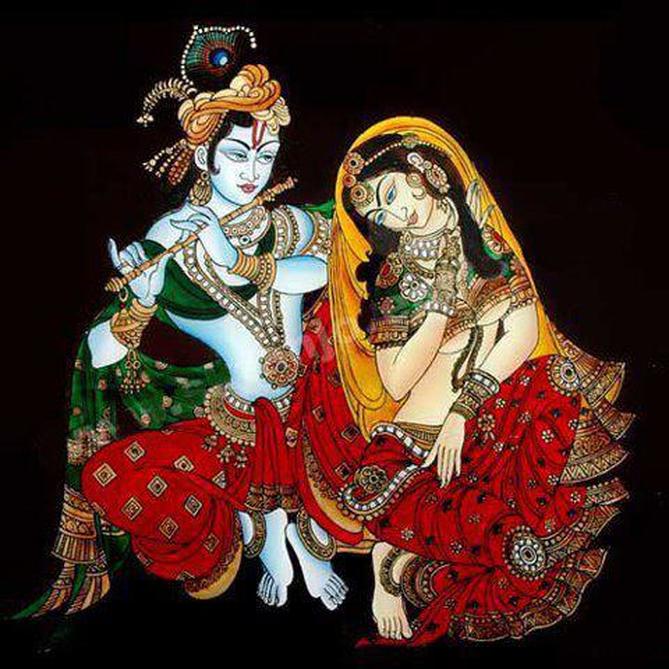
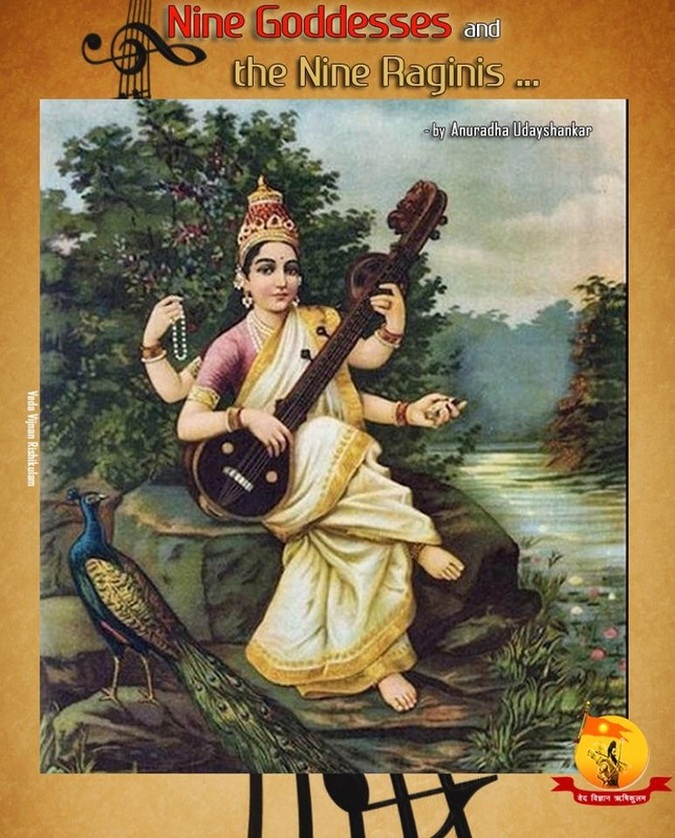
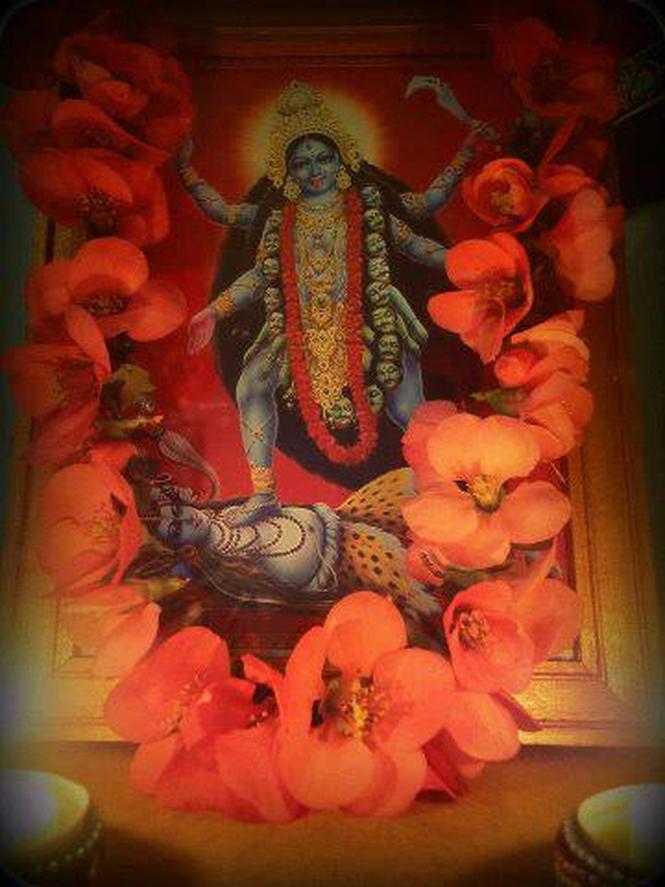
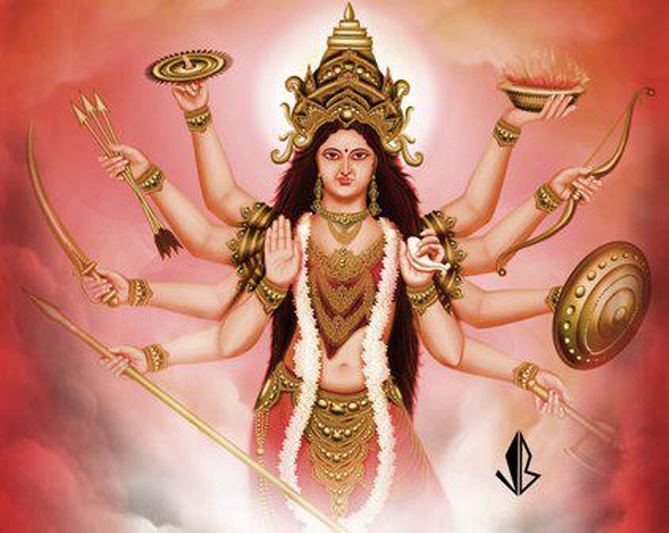
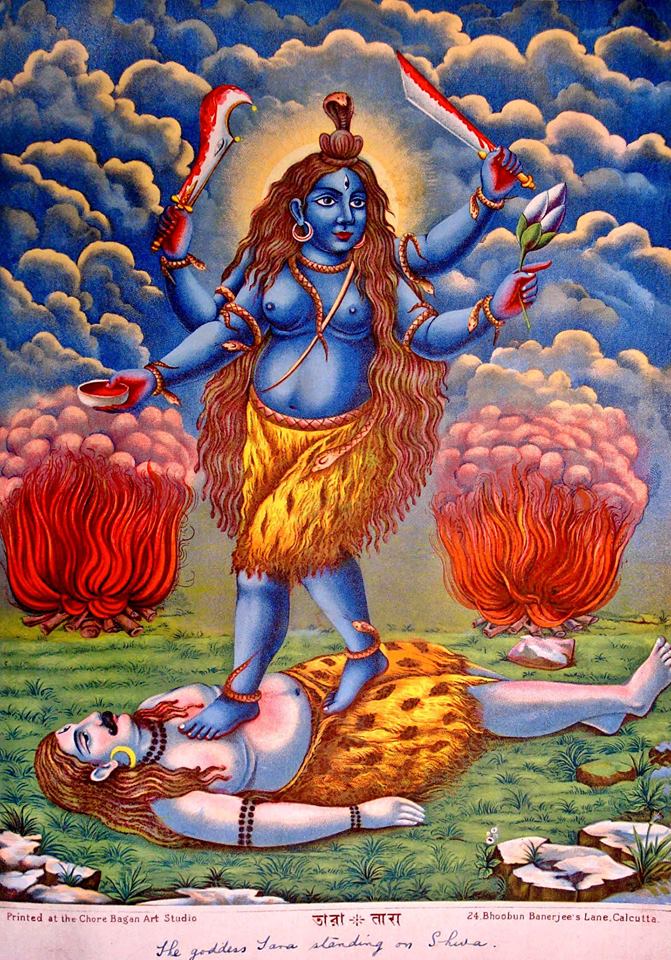
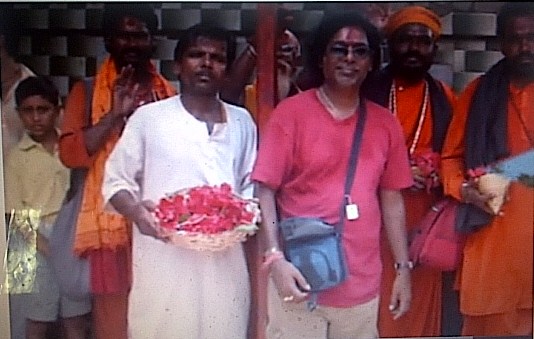
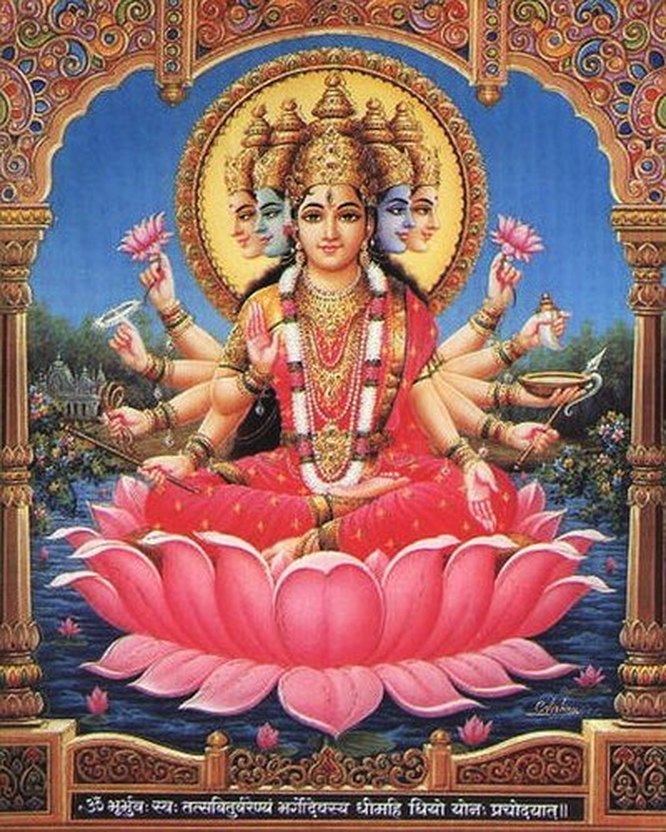
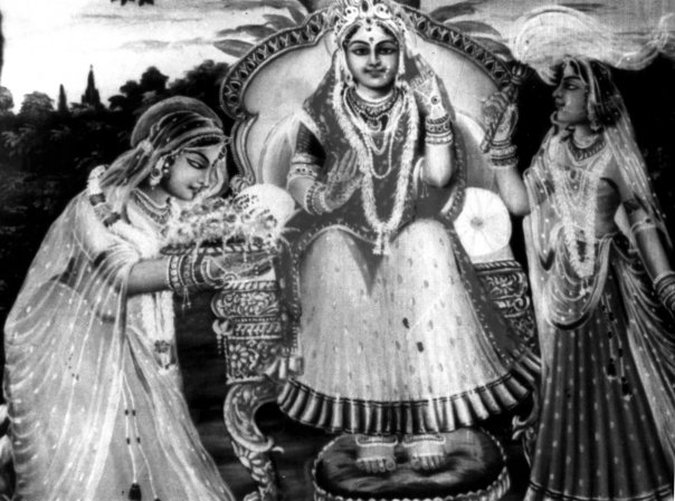
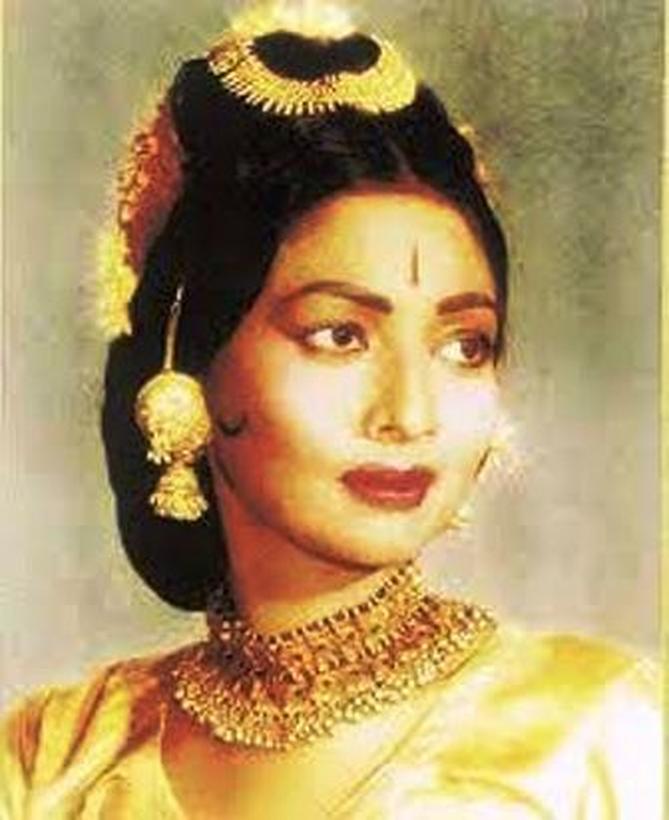
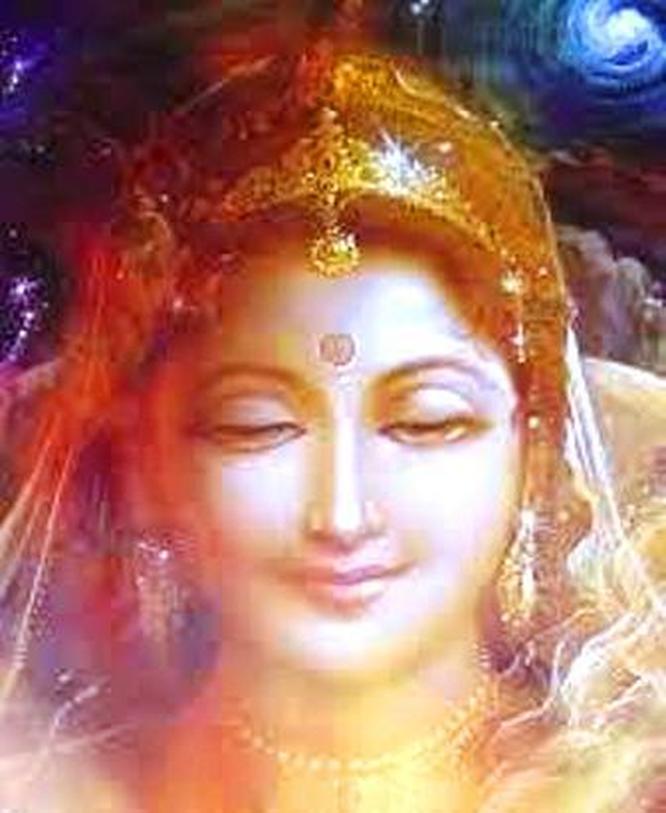
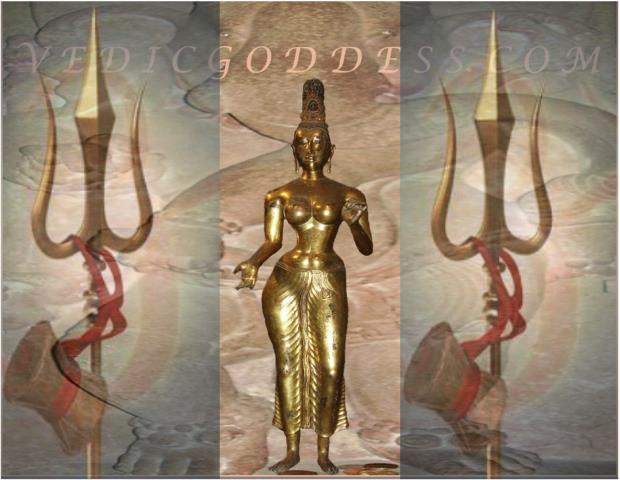
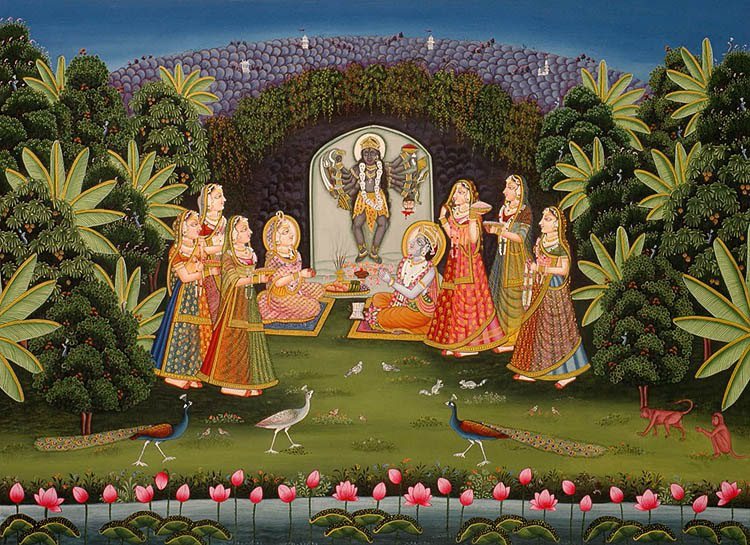

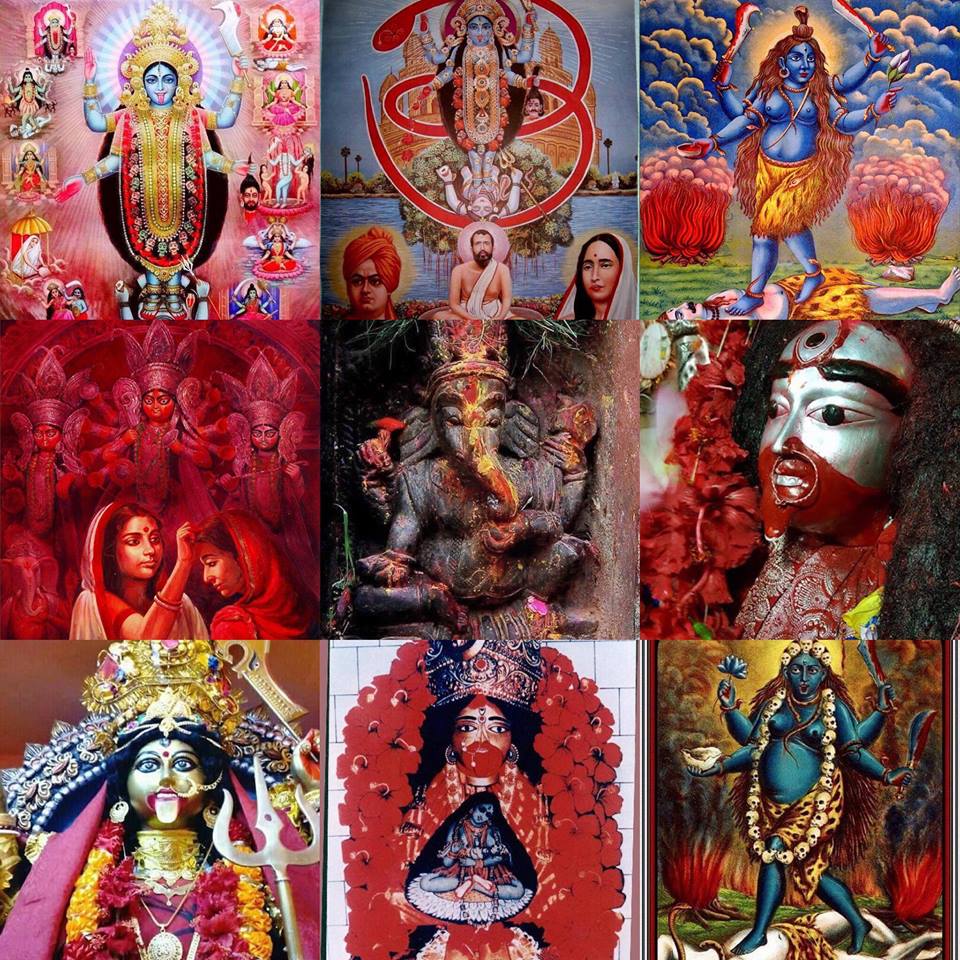
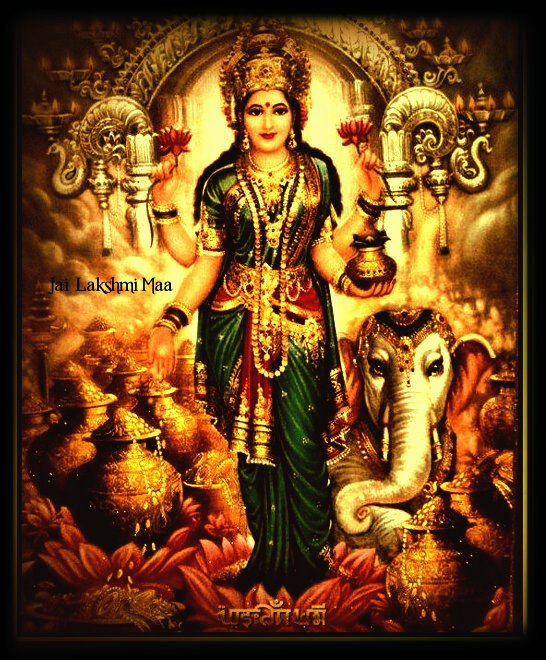
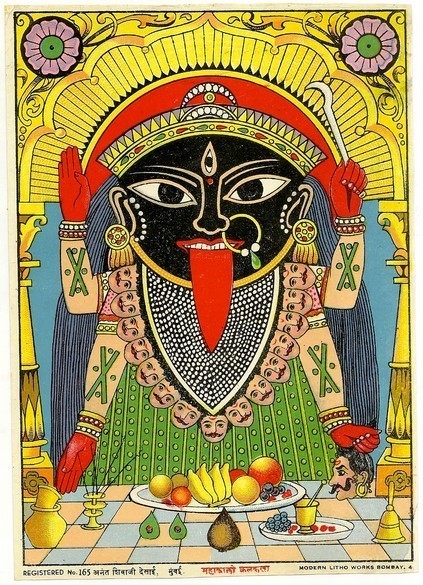
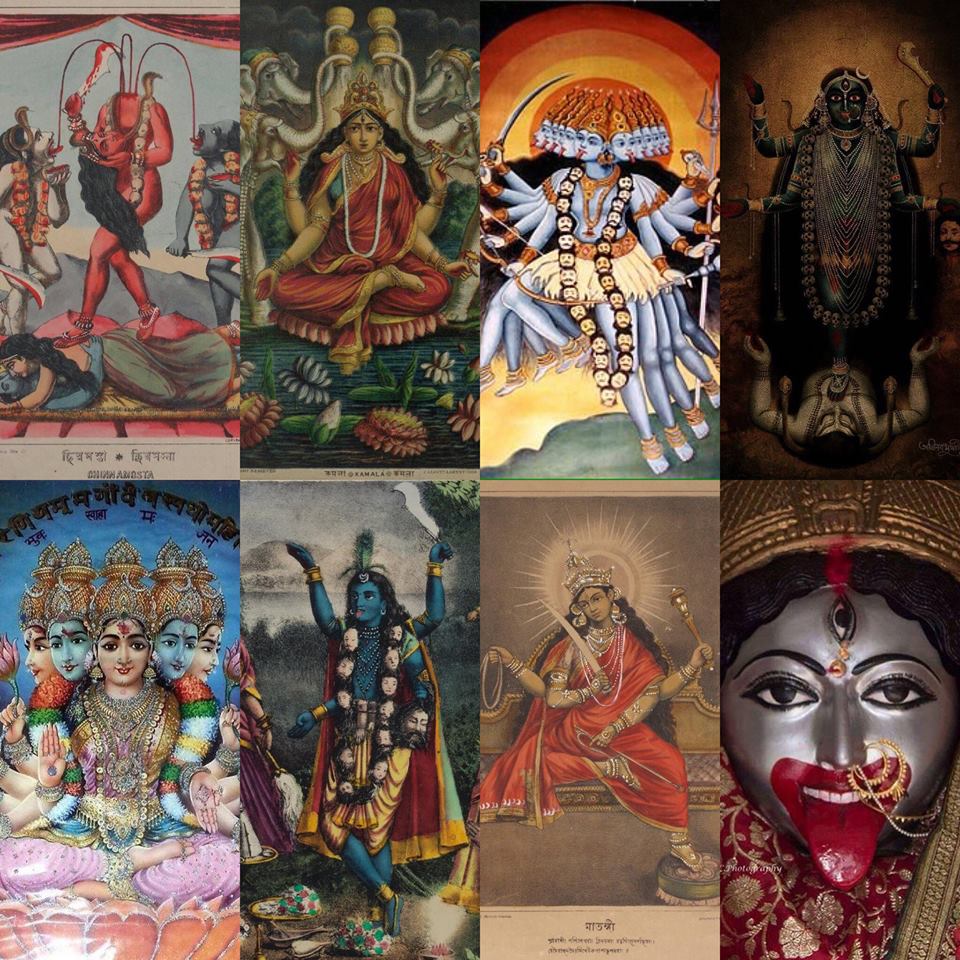
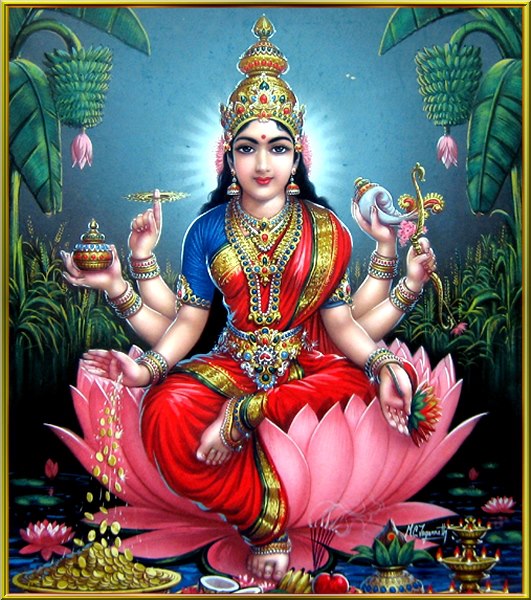
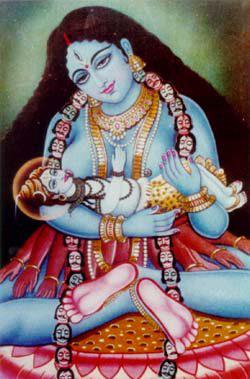
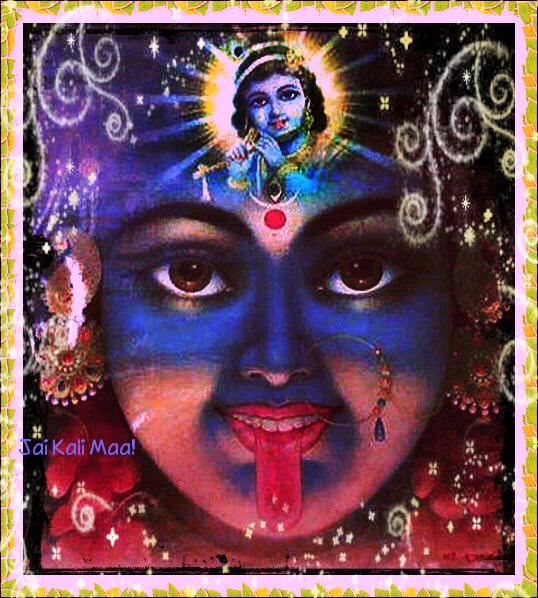
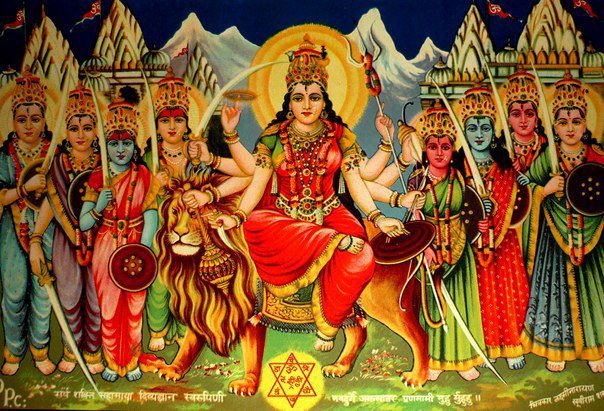
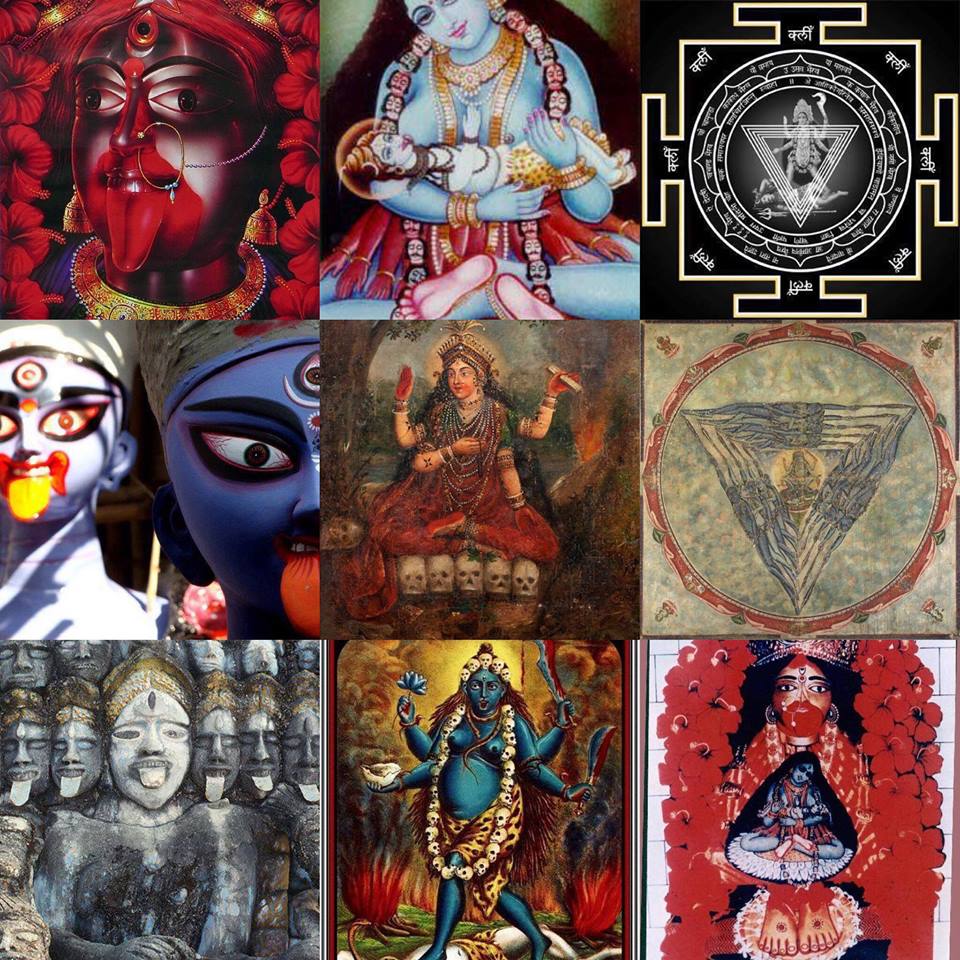
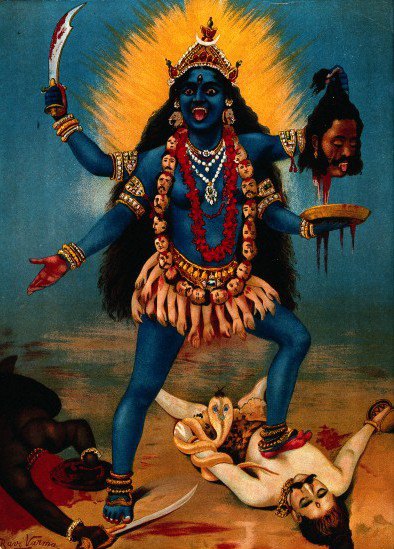
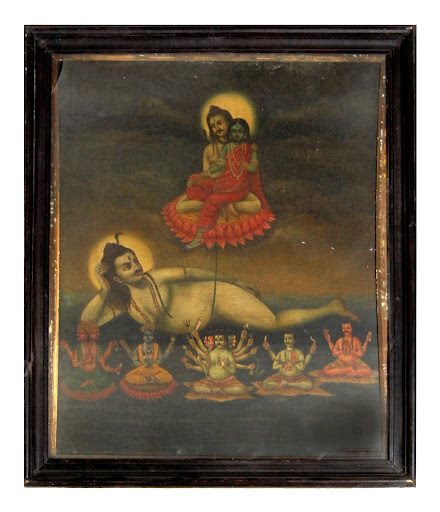
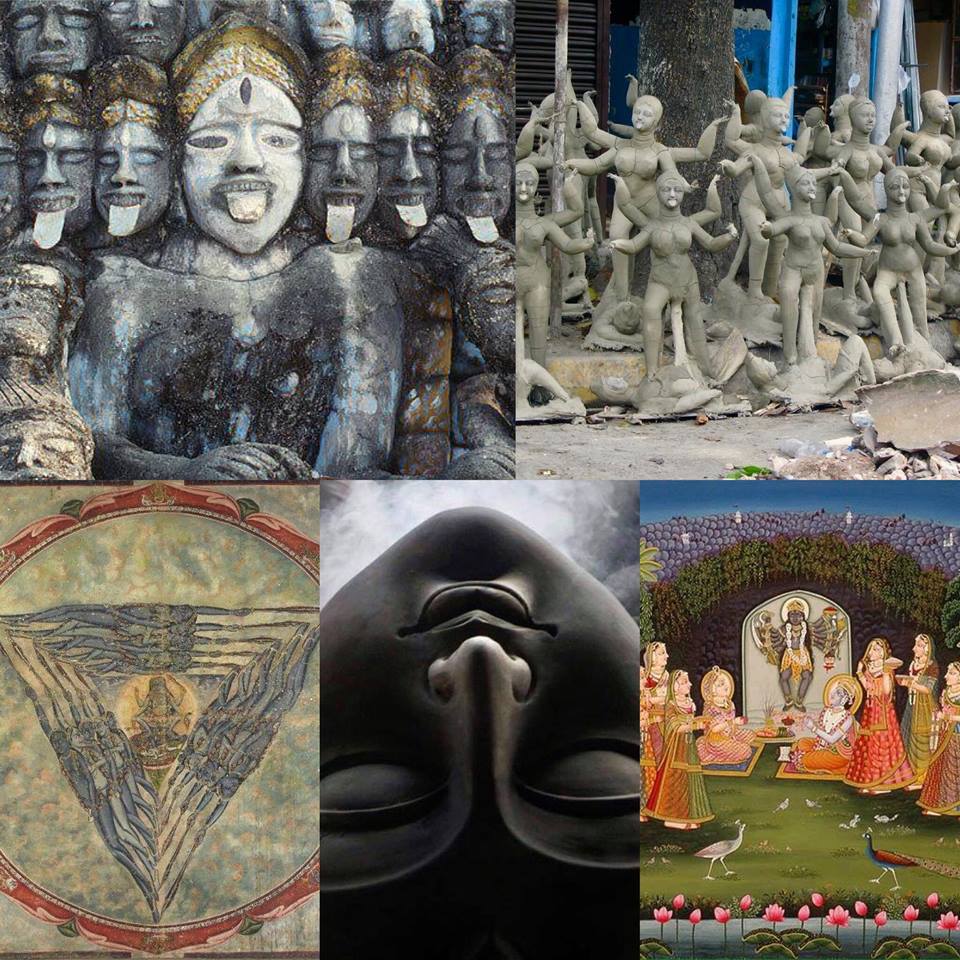
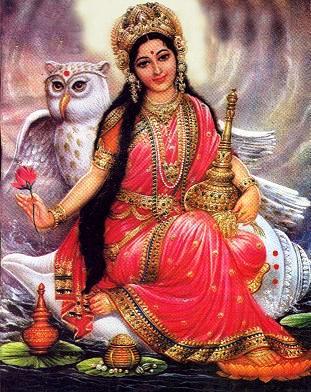
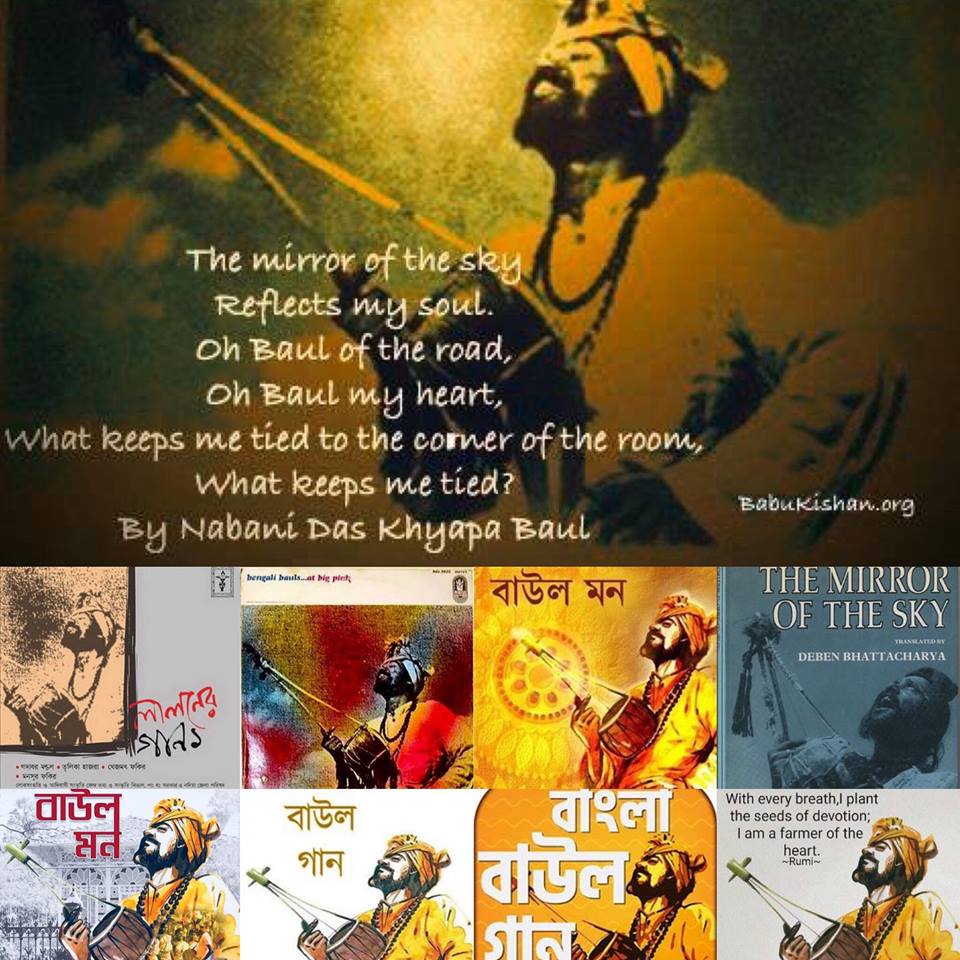
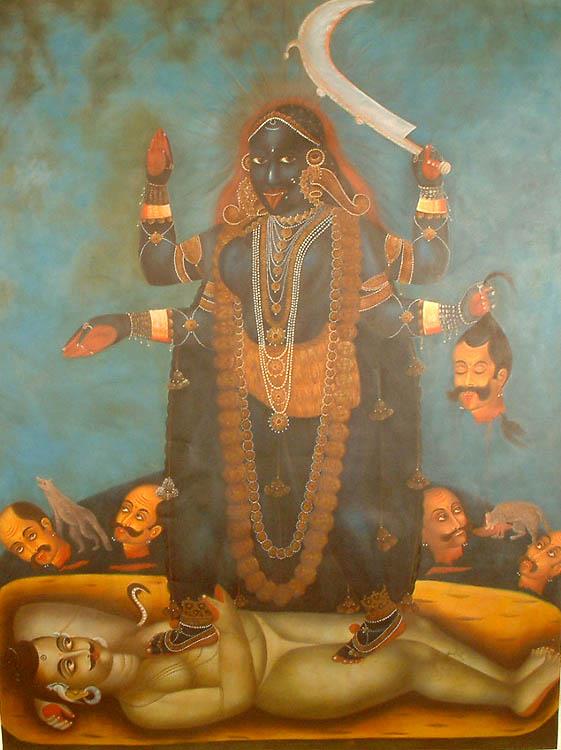
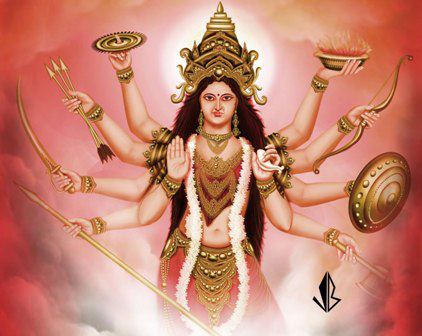
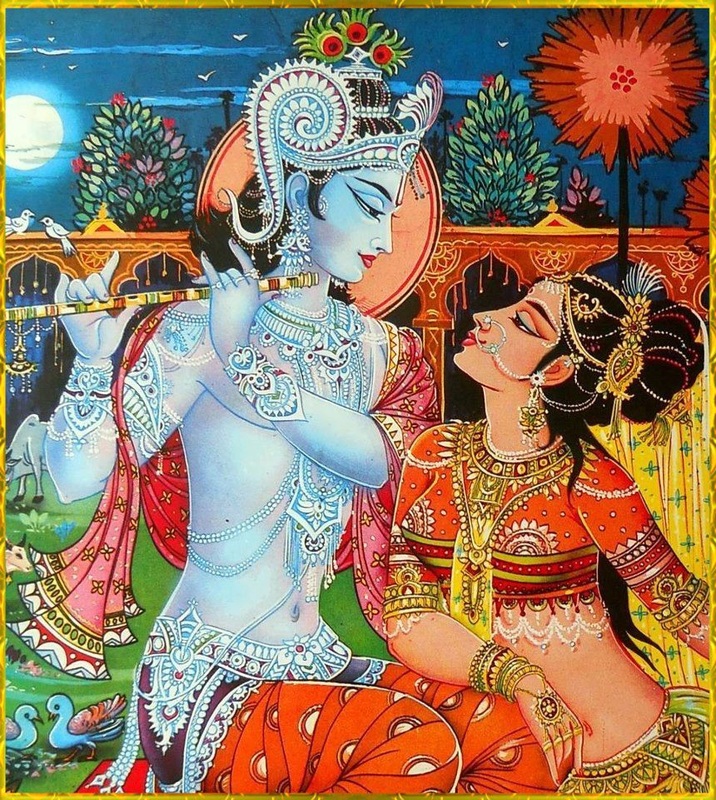
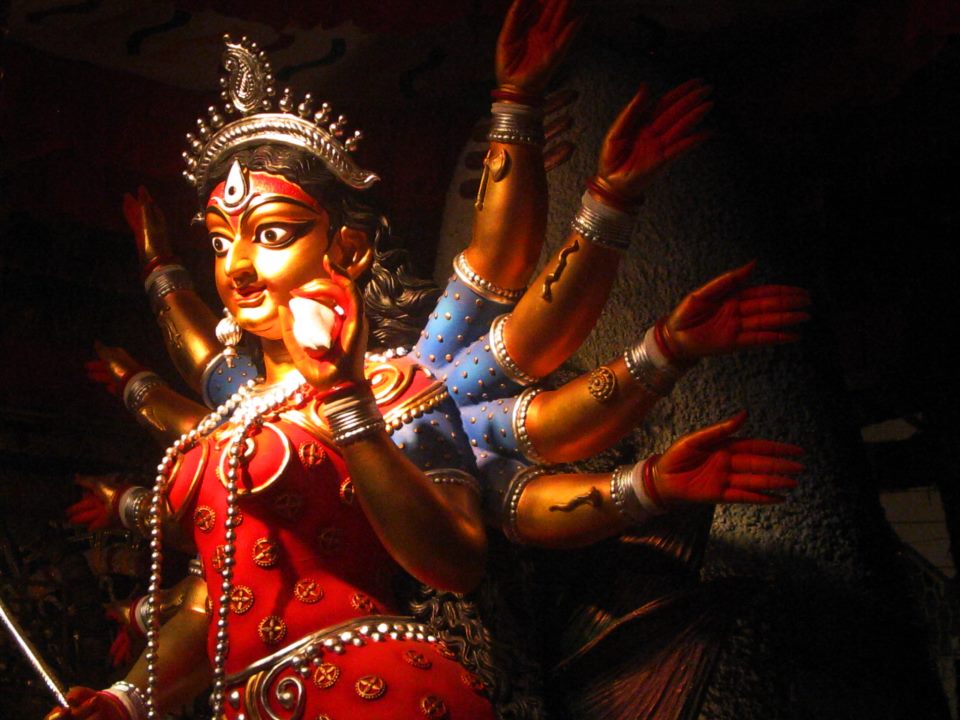
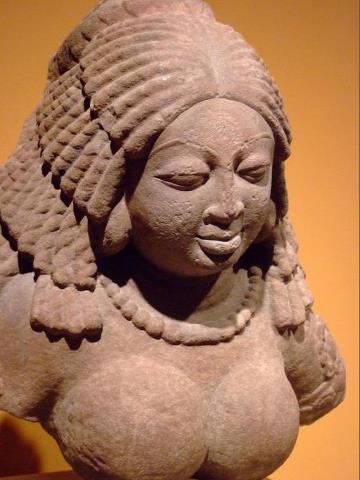
 RSS Feed
RSS Feed
